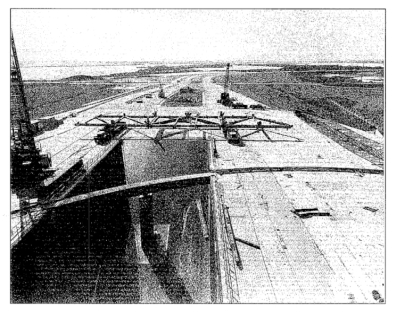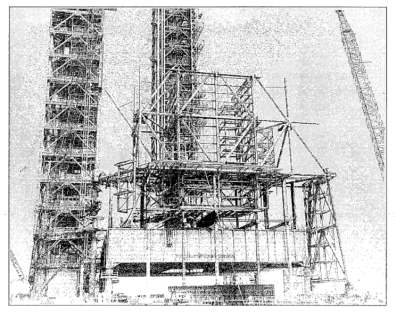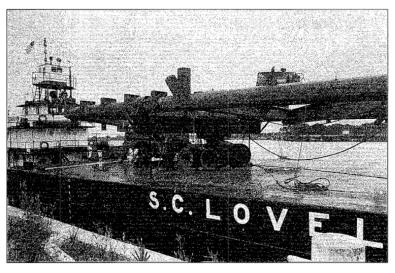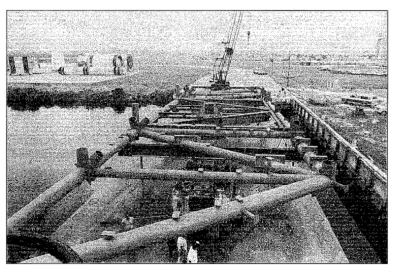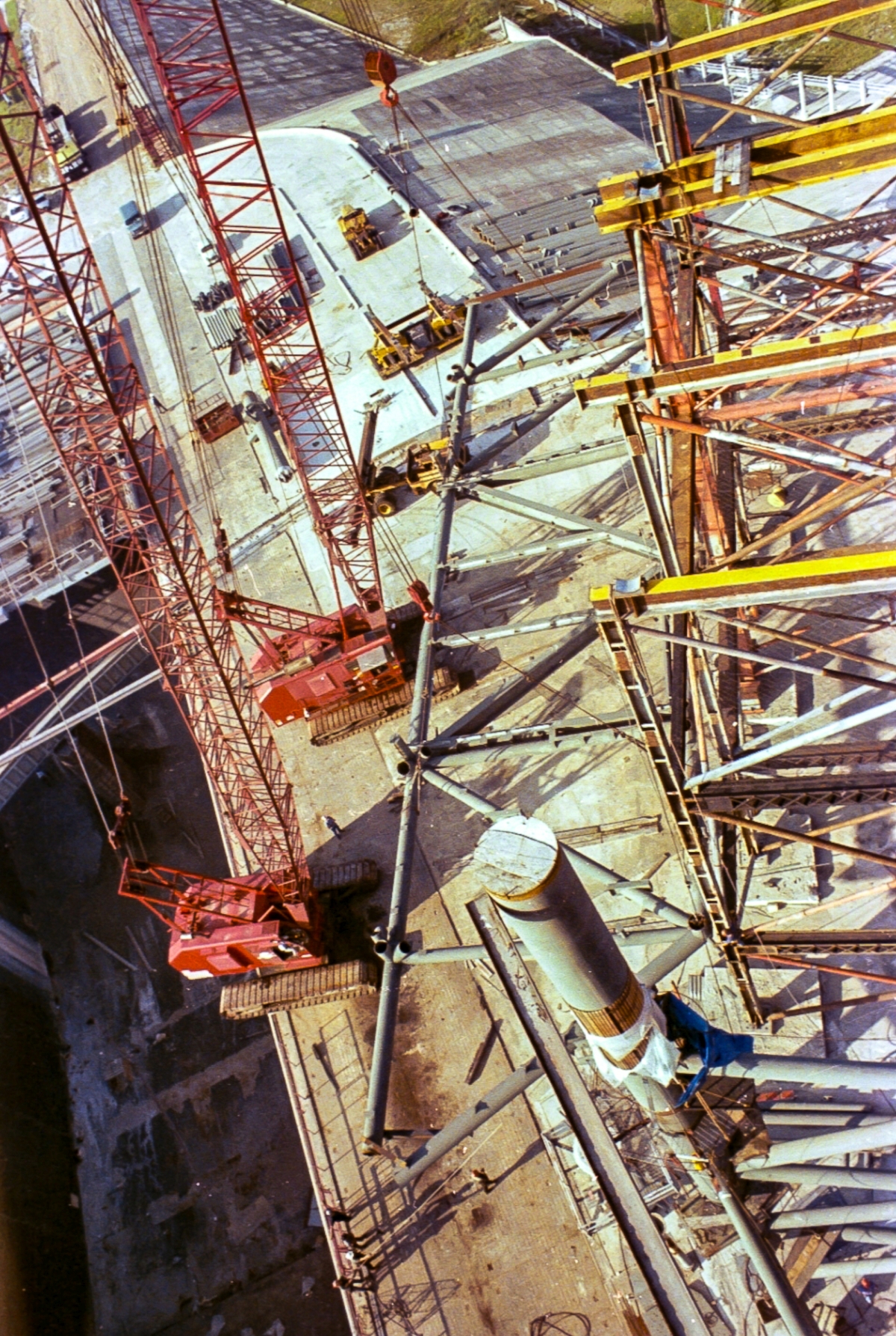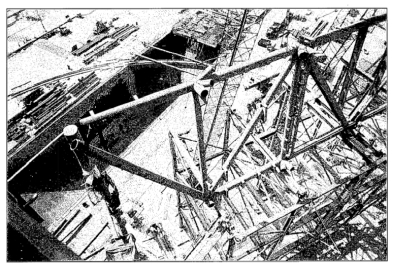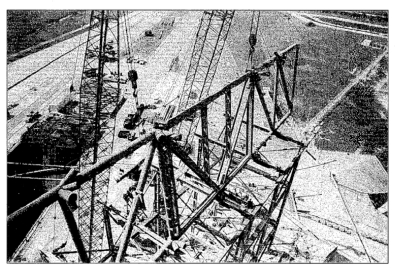The Construction of Space Shuttle Launch Complex 39-B
A very personal and technical written and photographic history, by James MacLaren.
Page 62: Gox Arm Hinges Strongback Lift ...and the RSS Bottom Truss Lift, too.
| Pad B Stories - Table of Contents |
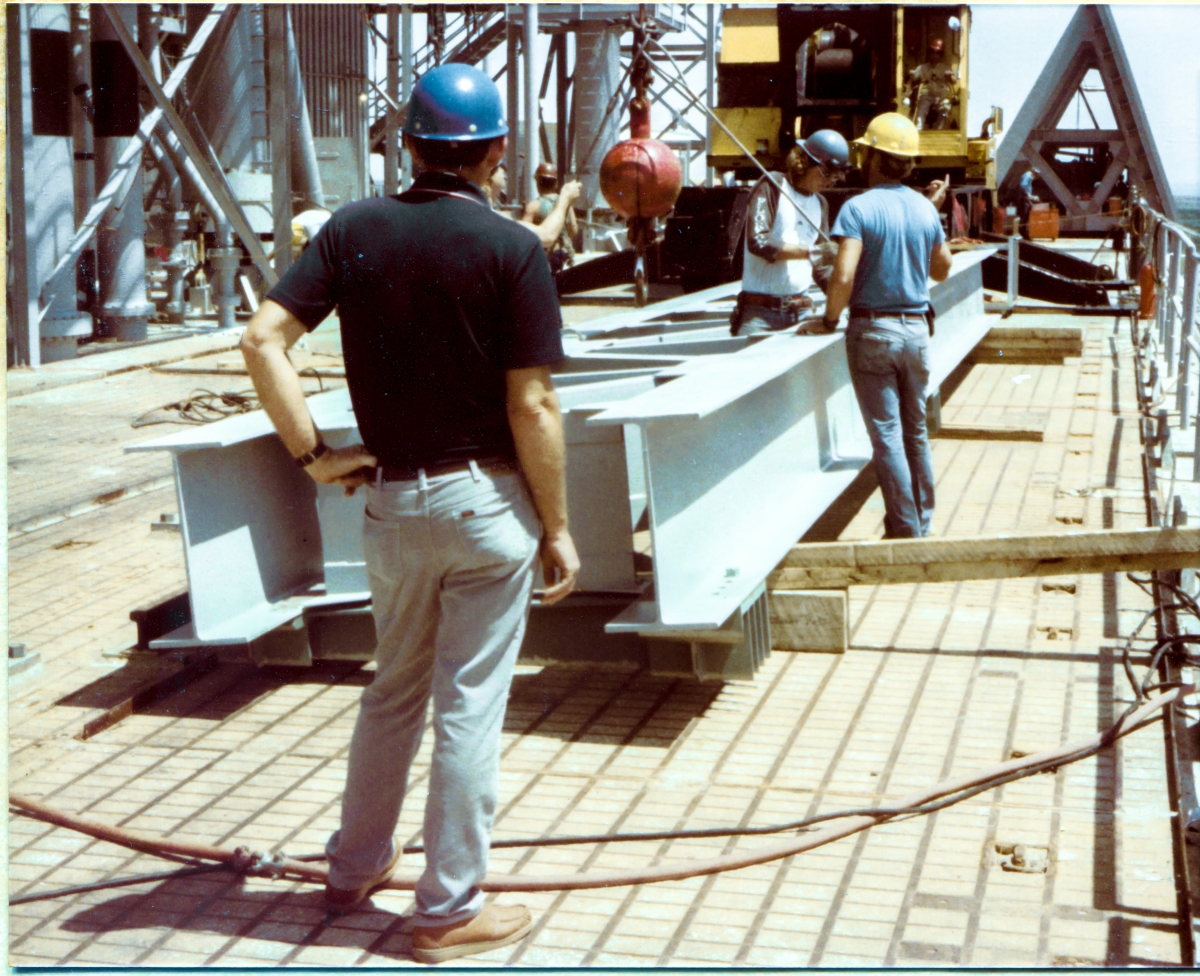
This thing.
We're going to be hanging this thing on the FSS, lifting the top end of it just about 250 feet above where you see it here on the Pad Deck at elevation 53'-0", facing Wade Ivey (blue hardhat, dark shirt, back toward camera), all the way up a little past the top edge of the FSS at elevation 300'-0", where the whole thing will be welded to 40 vertical feet of the Primary Framing of the tower so as they can then attach the Hinges of the GOX Arm to it, and it needs to be in between the GOX Arm and the FSS because the GOX Arm (which is quite the substantial item in and of itself, and constitutes one hell of a force-magnifying lever arm, and we'll be seeing plenty more of it, later on) will be swinging on its Hinges, and the forces involved with the initiation, continuation, relocation, and arresting of that rotation are substantial, and the FSS needs to be significantly stiffened up where the GOX Arm attaches to it, and this thing is what does that stiffening.
It's 43'-4" long, 5'-8" wide outside edge to outside edge, and it weighs just about 12,000 pounds.
It's a serious fucking piece of iron.
It's a great goddamned big steel monster, it's going 250 feet straight up, and Union Ironworkers from Local 808 will be placing themselves in very life-threatening positions to get it bolted and welded down, and we're going to get to witness the whole process, from one end to the other via the series of photographs I took of it, which you will be seeing in sequence as we scroll down this page.
We're going to be doing a lift.
And you have been given admittance into a place, at a time, where and when nobody is allowed to enter because it's fucking dangerous in here right now, compliments of James MacLaren, who wangled a camera permit, knew where to step and where not to step (well... for the most part, anyway), and was tolerated well enough by those who did the actual work, to permit them to suffer his camera-carrying presence without shooing him away from the area and getting him the hell out of there and getting him the hell out of the way.
Way to go, MacLaren!
And this first photograph is just loaded with information, and I'm going to linger over it for a while, pointing out various things and aspects to it which you might not have properly apprehended on your first glance.
We'll start with Wade Ivey, back to camera, light pants, dark shirt, blue hardhat.
Wade Ivey was Ivey Steel.
Ex-ironworker. Extraordinarily savvy. Knew how to hold down steel-erection costs in no end of clever and cunning ways to allow himself to come in low bidder, get the job, and then bring the job in, on time and under budget, staying afloat, prospering, in an extremely risky financial environment where people and companies routinely went bankrupt or otherwise came to bad ends.
Knew how to choose people to do the work. Went with the best, every time, and he had a very sharp eye for sizing people up, and then getting them to do their very best, reaching above and beyond themselves on a regular basis.
Practiced leadership with a very soft touch, and embodied the premise of employing only the very best people to do the work, and then getting the hell out of their way to let them do the goddamned work, without interference, even as he watched everything like a hawk.
In similar manner as Cecil Wilhoit, he came from the ground up, knew exactly what it felt like to have his feet on the ground, and let good men and good women work things out for themselves, knowing they were good, and further knowing they would work it out.
So yeah, Wade Ivey was The Man.
Next up is Rink Chiles, back mostly to camera, blue shirt, yellow hardhat.
Rink (his given name was Reynsol but he did not like it and preferred to be called Rink), was also extraordinarily savvy in the ways of ironworking, but possessed none of Wade's soft touch when it came to getting the work done.
Rink spoke with a soft southern drawl, but was possessed of a fiery disposition. His movements and body language were easy, almost languid, but he was a toweringly high-energy person. That high energy remained near-perfectly inert when not being directly employed in whatever he might have been doing (or not doing) at the time, but had the exact same characteristics as a dust-covered wooden case sitting in an out-of-the-way corner of a shed somewhere, filled with sticks of dynamite, and he could set things off, one stick at a time, or even the whole case, if need be, and... he was a formidable presence.
He knew what he was doing, and he further knew he was better at it than anybody else on the jobsite, brooked zero bullshit about any of it, and people who encroached on his time with what he knew to be bullshit would find out right now, how things were going to be, whether they wanted them to be that way or not.
I got along just fine with Rink, never had any problems with him, worked as a teammate with him doing what I could to solve problems he encountered on the job, day-to-day on the paperwork end of things, (which he himself despised and was always more than happy to be handing that end of things off to me, or my boss Dick Walls), and things were oftentimes downright fun around him... I tend to gravitate toward high-energy high-talent people to the extent that they will put up with me, and I enjoyed Rink's company whenever time and circumstance on the job placed us together, be it up on the iron, or down in the field trailer.
But that dusty wooden box was clearly-enough stenciled with the word "DYNAMITE" and it always needed to be given the full respect which it was due.
Beyond Rink, head down working with the rigging, white shirt with dark sleeves, blue hardhat, is his brother Reuben.
Reuben was another formidable presence, but his was a darker one, not nearly as highly-skilled an ironworker as his brother Rink (but plenty high-skilled anyway), and I never became very close to him in any way at all. He exuded an aura of... I don't even know what to call it, but it was somehow clearly warning me to give him a little extra room, keeping him at a little extra distance, at all times, and I did so, and we never once came into conflict, but... I could feel it (I inherited my mother's "radar" and it alerts me in an unknown way that I do not question, and it has kept me clear of many things over the years which wound up turning out poorly for other people), and I dealt with him accordingly, which is to say, nearly not at all.
And Reuben, engaged with the rigging, segues us into the next potentially-unapprehended aspect of out photograph, which is the fact that the wire-rope sling that he is hands-on with (as well as someone else hidden behind Wade Ivey, all except for an arm and hand, on the other half of the two-leg sling) is in tension.
I took this image at the exact moment that the crane operator was beginning to "get up on it" and if you look at Rink you can see that he's got his right hand up, signaling the crane operator to begin coming up on things, slowly, and the crane operator is looking directly at Rink, and Rink's left hand is resting on top of the Strongback, feeling for when it begins to come alive, and there's one hell of a lot of action going on, despite the fact that, with the exception of crane's jib line and the rigging attached to it, nothing has moved so much as a half millimeter just yet.
Forces, are coming into play, and with ironworking, the forces ramp upward nearly without limit, well beyond superhuman, and must always be monitored with tack-sharp awareness, because they almost always possess the hidden (and sometimes not so hidden) power to just go right through things as if they weren't there at all. Terrible terrible consequences are always lurking just around the corner, hidden, and everlasting vigilance is the only defense against them. And once in a great while, even that isn't enough to stave them off. It's fucking dangerous out here. Waaaay more dangerous than anyone who has not spent the time out here can ever know, can ever understand, even after they've been told about it.
Look closely at the wire-rope sling that Ruben's hands-on with, up at its top end. It is connected to a shackle above the headache ball, and on that end it is a swedged loop of wire, and although the main length of this leg of the sling is clearly and obviously ruler-straight, clearly and obviously in tension, already feeling more than enough force to rip your arm off or even rip you cleanly in half at the waist, the swedged loop remains open.
I can't quite tell if that's 1" or ¾" wire rope making up the sling, but either way, it's stiff, and although it's flexible, it bears no resemblance to rope of equal diameter made from nylon or manila, which is vastly more loose, limp, and prone to flop around like a piece of well-cooked spaghetti.
It'll bend, but it doesn't really want to bend, and when bent into a tight-radius arc such as what it's being bent through up where it passes through the shackle tying it to the crane's jib line, it's going to take some FORCE to do that, and in our photograph, clearly, at the moment, that much force has yet to be applied, and the loop remains open, and this is how we tell, with exquisite accuracy, at a glance, just exactly how much force is being applied.
And never in your life would you have noticed such a thing unless I had pointed it out to you, or unless you had personal experience with this sort of thing.
And our Union Ironworkers, under the watchful gaze of Wade and Rink, whose eyes are locked on the area where the sling is tied with shackles to the jib line above the headache ball, are seeing to it that the sling, both legs, both ends, and the shackles, will not find a way to hang up, to snag, as the forces continue to ramp ever upward, in a way that might permit it to suddenly jump, to suddenly become unhung, sending a potentially lethal shock through the rigging. A shock that could cause things to suddenly become unsupported as a vice-tight connection suddenly jumps into a configuration where there is room... slack... give... which could all too easily result in a suspended load near-instantaneously repositioning... ...or falling... ...catastrophically.
The exact split second I hit the shutter release is a life-threateningly dangerous moment, and everybody in the photograph knows this, and they are seeing to it that a mistake is not going to be made at this juncture of things.
And at some point somebody needs to be asking themselves, "Why in the name of hell did they tie that sling to the jib line above the headache ball with a bunch of ratty-looking shackles?!? Why in the name of hell are they not using the hook? Why are they not using the thing that was purpose-designed for exactly this sort of operation? The thing that's dangling down beneath the headache ball, completely empty and unused."
Good question. We'll be revisiting this question later on, farther down this page, but not yet, not now.
For now, you get to puzzle over it on your own.
Let us now pull our attention away from the Lift, and take this moment to look around at where we are.
Up on the Pad Deck.
West of the Flame Trench, more or less right in front of the FSS, which remains unseen, just out of frame to the left.
Go back to Page 41 and have a look around, once again. Reconnect with a few old friends. The MLP Utilities Interface Platform. The 9099 Building. MLP Mount Mechanisms 4 and 5. The Lox Tower. The West Tower of the North Piping Bridge. They're all here, now, all visible in our photograph at the top of this page.
And the Crawlerway Removable Grid Panels, resting upon the roof of the Buried Stone Castle, stoically bearing their loads. That which holds up our Strongback. And the people getting ready to lift it. And the crane which will do that lifting. Page 59 is where you can reconnect with the Grid Panels and an awful lot more, too.
And the West Side Flame Deflector. Which we met just before we took a ride in the Skip Box, back on Page 13.
They're all here, and more.
Ok. Back to the Strongback.
Here it is here, on 79K24048, sheet S-107, highlighted for you, and while we're here, I couldn't miss a another chance to take a swipe at the horseshit engineering on these PRC/BRPH drawings could I? So go find Section J, and then tell me where it's cut from. Yeah. I know where it's cut from, and I further know it's part of the Latchback stuff which is also shown on this drawing, and that's why it's not blue highlighted, but... yeah. Crap-ass drawings. Sigh.
As I've previously mentioned, it's a fairly substantial item to be going 250 feet straight up with.
Ok. Let's get on with this lift.
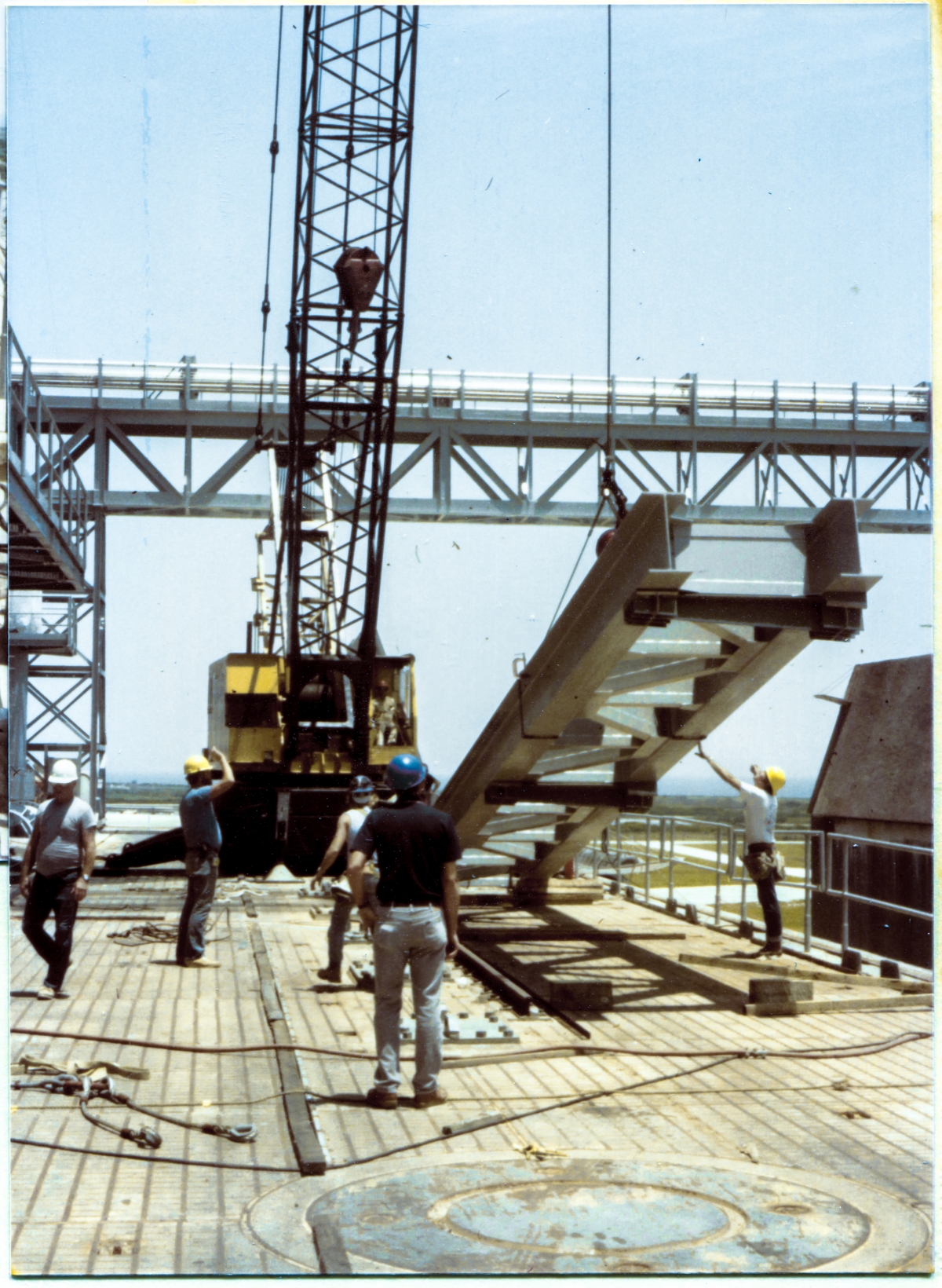
And we are now underway with the lift, and things have begun moving.
Things remain exceedingly dangerous as the suspended load bears down, heavier and heavier, on the rigging which continues to urge it ever upward.
And now we can get a much better look at just how bizarrely they've chosen to attach their lifting sling to the Strongback.
Not only are they not using the crane hook to pick it up with, they've tied on to it with a pair of choker slings, one on each side, about a third of the way down from its top end, in a place where there doesn't seem to be anything to keep it from slipping down, above and beyond a common C Clamp!
What madness is this?
But these are people who feel iron in ways that you and I can never experience. They are not reckless. And they are not stupid.
They know exactly what they're doing, and we'll just have to wait a little longer to find out... why?
If something was to let go, this would very likely be the time it would happen.
Everybody involved knows this, but they also know that they themselves, and the small group of people they're working with, are as good as it gets with this sort of thing, trust themselves and the rest of the team with their very lives, and place themselves directly in harm's way in order to make it happen.
Very short shadows beneath everyone tell us that it's very near high noon on a blazingly-hot summer day in Florida, and Rink has his hand up to block the sun from his eyes as he casts his gaze low and high, watching everything vigilantly.
To Rink's left, (light blue shirt, white hard hat), sauntering away from things, Harvey Dixon, Wade Ivey's right-hand-man, momentarily takes his attention completely away from what is going on right behind him.
To Rink's right, partially obscured by Wade Ivey, (back to camera, white tank top), Harvey's son James steps smartly toward the end of the Strongback which is still in contact with the ground, surveying the action from every side as he does so.
Wade Ivey remains back to camera, just far away to keep from getting into someone's path, looking directly toward where the lifting sling is attached to the Strongback, watching it like a hawk, making sure all is well and nothing is shifting, or otherwise showing signs of instability.
To Wade's right, (outstretched hand on the Strongback, white shirt, yellow hardhat), an ironworker I cannot identify, alas, watches the lifting sling from the other side while feeling for any untoward motion or vibration in the partially-lifted Strongback.
The crane operator (alas, another name I can never give you) has located the tip of his crane's jib exactly above the center of the Strongback over 200 feet above him and only partially visible to him, and as the Strongback rises into the sky, you can see, clearly, that because of his pinpoint positioning of the line that's lifting the Strongback, the Strongback has not rotated, has not moved off to one side or the other as it comes up off the ground, and to verify this for yourself, you need only look at the grid pattern of steel in the Pad Deck, or the SFD Rail, or the angle iron for the Plywood right next to it, all of which run true, due north to due south, and then you look at the shadow of the Strongback...
Dead center.
Everybody was on that shit, had it come up off the ground and immediately started drifting to the left or the right...
But it wasn't necessary.
Dead center.
Our crane operator is as good as they get, just like everybody else involved with this lift.
Working to keep things in-frame with a fixed-zoom lens, I have stepped back farther away from the Strongback and moved across the Crawlerway a bit more to the west, closer to the still-unseen FSS looming far above my head, which the Strongback will be attached to, continuing to work my camera, trying to frame the best possible shot, as a dynamic situation continues to inexorably unfold.
As I moved around the lift, the scene in-frame has shifted, and the West Side Flame Deflector is now behind the crane, and the East Side Flame Deflector has come partially into view across the open gap of the Flame Trench, extending out of frame on the right side, just below and to the right of the lifted top-end of the Strongback.
Extending out of frame along the bottom edge, the round outline of the Top Bearing Plate for Extensible Column Foundation 13 has come into view.
Immediately to the left of Wade Ivey's feet and extending into the distance all the way until it disappears into the darkness beneath the crane, a line of 2x4's has been placed flush up against the west side of the angle iron that is used to temporarily secure the Plywood Panels to the Crawlerway, the plywood that's a lubricant! which we also learned all about, back on Page 59. And this line of 2x4's is flush against the upstanding leg of that angle iron to keep it from damaging the rubber tires that the crane is on, and to also keep it from becoming damaged itself by being crushed out of shape. Little stuff. No end of "little stuff" right?
Left of that, more rigging lays unused (Bring everything you think you might need, use what turns out to be the most useful as yet another unique situation makes itself clear to you in the doing of it, and come back after you're done and clean it all up and put it all away. Far better to have a piece you don't need, than to need a piece you don't have.) on the Pad Deck between what appears to be a couple of Air Hoses which supply air-powered tools... someplace, employed by... somebody, and we'll never know where or who. An electric cord runs beneath the unused rigging, to the left of the run of 2x4's and to the right, Wade Ivey is standing directly on top of it. Just to the right of Wade's feet, 2x2's flush against them protect the Air Hoses from being crushed by the crane, or anything else moving around on the Pad Deck.
Cribbing is revealed where the Strongback had been laying, protecting it from becoming damaged by direct contact with the Crawlerway Grid Panels.
In the same area, a Side Flame Deflector Rail is visible, along with some of the Locking Lugs that are bolted down to the Pad Deck, to hold it firmly in place and keep it from getting blown away by the blast from the SRB's when the Space Shuttle takes off. Locking lugs for a thing that weighs a literal quarter-million pounds. Stop and consider the kind of force that might require tying down a quarter million pounds, to keep it from blowing away. Whoa.
The underside of the Strongback has now become visible, and two of the three curiously-slanted weldments which will be what connects it directly to the FSS, via more welding, can be seen clearly. This is sturdy stuff. Maybe go back to 79K24048, sheet S-107, Details F and K, and look at that part of things again. Heavy-enough iron, and quite closely-spaced. Sturdy. Very very sturdy.
And as the Strongback comes up off the ground, it's apparent size begins to grow, and more and more you can see what they're really dealing with here.
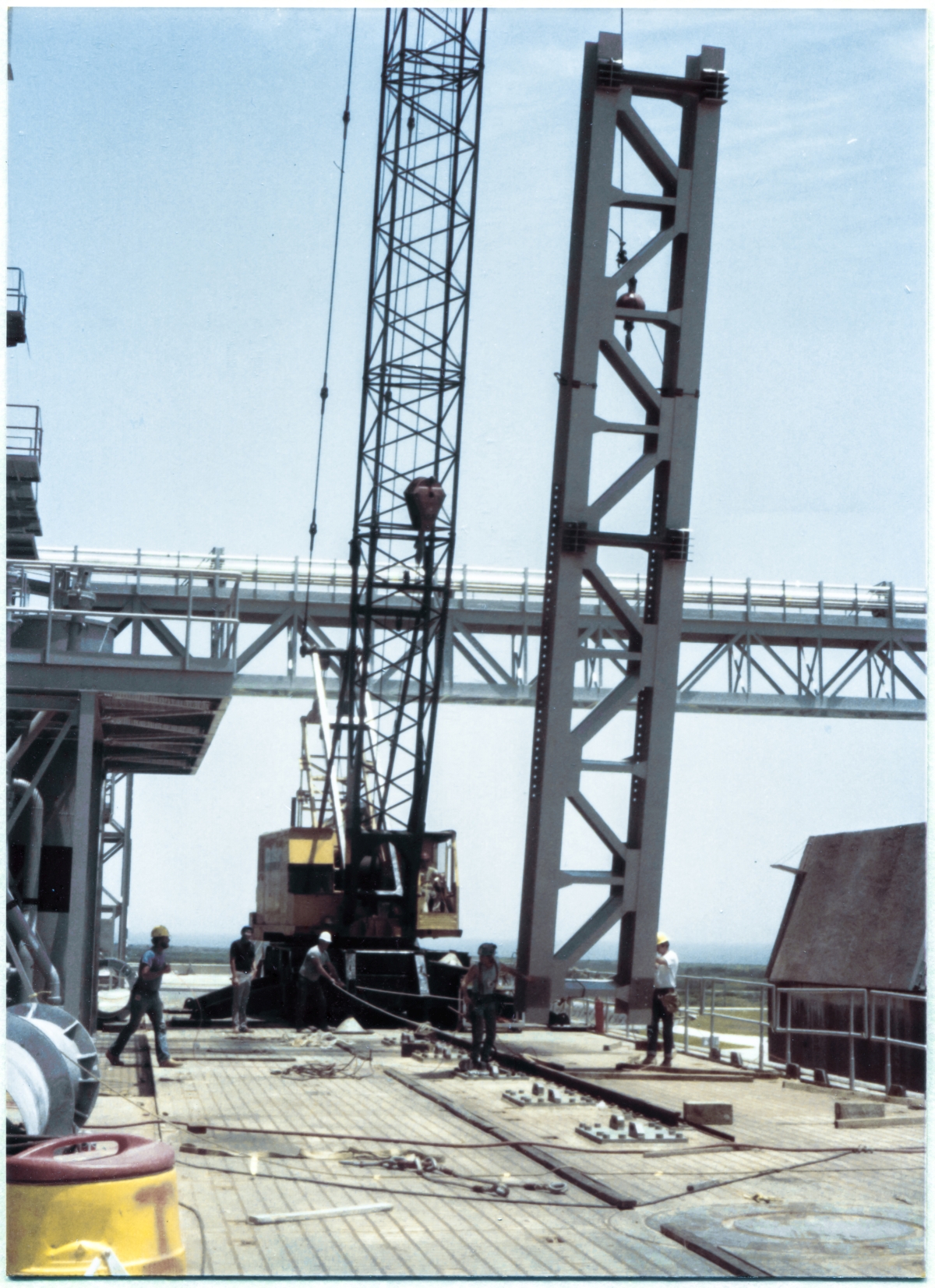
And now the true scale of the thing becomes obvious, as it looms above the puny humans who are working with it, dwarfing them as it does so.
It is now hanging in free suspension, supported only by the bizarre lifting sling, for good or for bad. In this image, the headache ball can clearly be seen hanging off-center, away from the crane's jib line, its own attach hardware pulled to the side at a significant angle, bearing no load above and beyond its own weight. From this angle, the choker slings wrapped around the twin W24x104's which constitute the main body of the Strongback can be seen resting on pads at each corner of the wide-flanges to keep from chafing, preventing damage to not only the Strongback, but also the wire ropes of the slings.
This day, as so many other summertime days in Florida, had very light wind, almost none at all, and the Strongback remains in the orientation in which it was first lifted from Pad, and it looks like Harvey might be on a tag line, but then again maybe not, because whatever it is he's pulling on looks a bit too heavy, and might be another Air Line, but I cannot tell. Two ironworkers control the Strongback from its bottom, and something is going on between Rink and James which is causing Rink to quick-step it over toward James, who still has a hand on the Strongback, but is otherwise focused on Rink.
Large heavy objects, in suspension, have a deliciously uncanny feel about them. They want very much to fall to the ground, and that force, aimed directly downward, gives them a property of not wanting to be moved off of that lowest center-of-gravity point to which they have already self-located themselves to.
And the heavier they are, the more pronounced this characteristic is, and with our Strongback, it's in full force and effect.
But our Strongback also completely free to move around.
It has a great inertial mass, and that inertial mass strongly resists spinning it, or nudging it off to one side or the other, as a pendulum might move, even the slightest little bit, but... it's free... and it will move... and when it does, it feels... weird.
If you drove a car into it at high speed, the suspended Strongback would hardly move in the instant it took to completely crush the front end of the car. It's inertial resistance prevents it from immediately doing so. Once hit, it would move, of course, but the action is delayed, and it's delayed long enough to render the front end of the car into crumpled and shattered fragments, even as it suffers only minor blemishes itself.
But walk up to it. Put your hand on it. Put a single finger on it.
And give it a steady push.
And feel it yield. Feel it give way. Feel it reposition itself at no more impetus than is possessed by a single finger on your hand.
Slow. Syrupy. Motion.
And take your finger off of it, and it has to think about that for a bit, before whatever small motion you may have imbued it with begins to redirect once again back toward a perfect straight-up-and-down alignment with your local gravitational field.
Heavy things in suspension possess ferocious destructive energy of a weirdly-implacable nature, but at one and the same time, they're really fun to... just play around with.
And today, nobody has time to be playing around with our Strongback, but once in a while, things will happen just so, and you'll find yourself there with a gang of ironworkers working on a suspended some damn thing or other, be it in the shakeout yard or up on high steel, and for... time... nobody is actually doing anything with it while unfinished arrangements elsewhere demand it be just... left there... in suspension... and The Fates will permit you... with the concurrence of the gang of ironworkers...
...to play around with it.
Just a little.
Just a very very little.
Just to feel the syrupy motion, once again.
I cannot describe it.
But it's fun.
Or at least it was fun for me, anyway.
And, speaking of "fun", on days when the wind has picked up enough to become a factor...
Yeah...
That can become "fun" too.
The kind of "fun" you never ever want to cross paths with.
But not today. Today the wind is near non-existent, and the Strongback will be well-behaved throughout the full term of our lift.
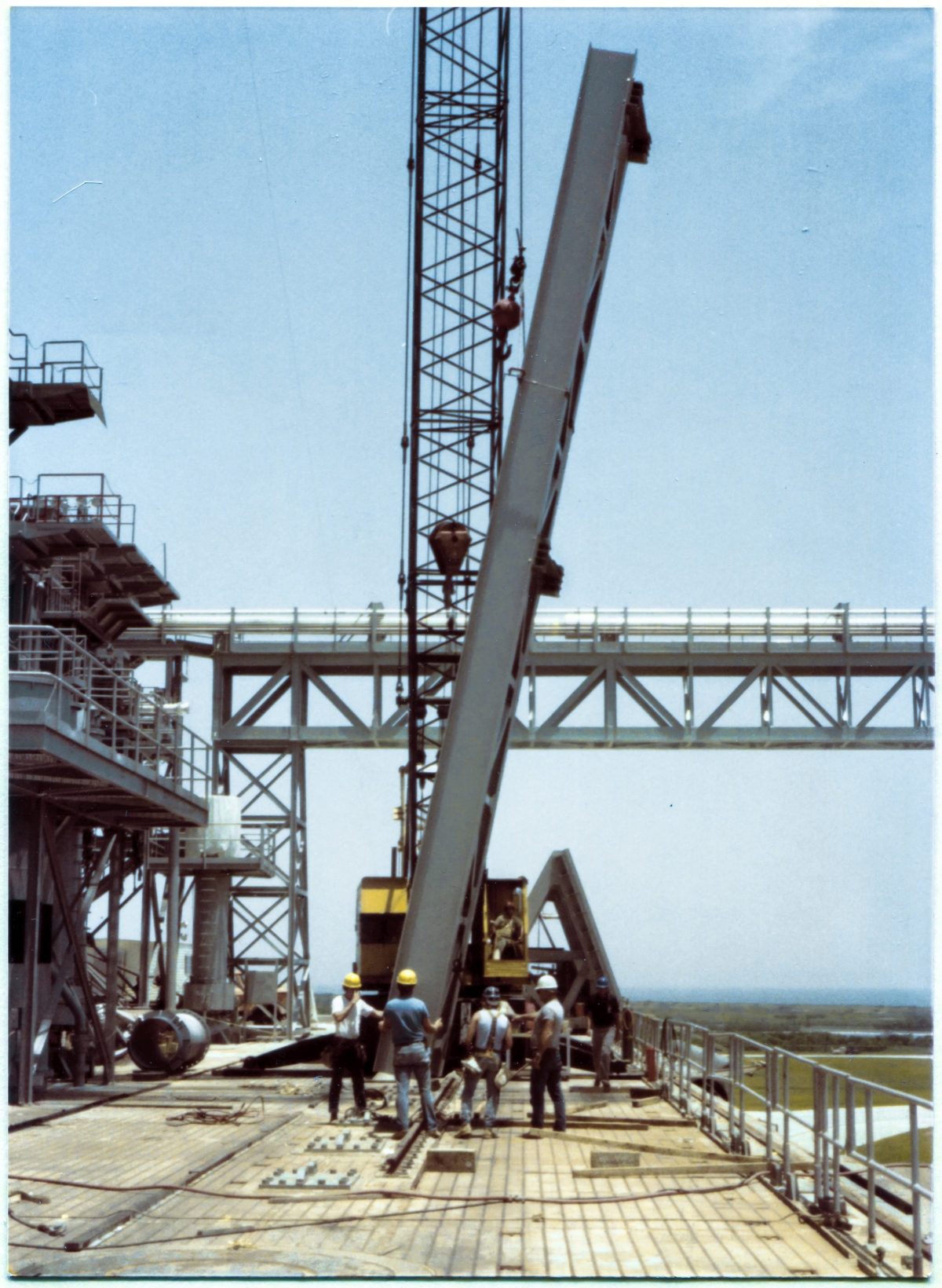
And now that it's up off the ground, but still within easy reach, everyone gathers together to consider the particulars of what's coming next. The orientation of the Strongback has by now been rotated through ninety degrees from where it was originally laying, face up, and it's now facing directly away from where it will be oriented when it gets welded to the tower, and this is easily-enough seen by noticing where the two connection weldments, one at the top, and one half way down its length, are located. It's those weldments which will come into direct contact with the Primary Framing of the FSS on Side 1, which remains unseen, just out of frame, to the left, opposite of where the connection weldments are seen in this image. During lifts, orientations of that which is being lifted do not necessarily match their final orientations, and this can be for any number of reasons, most of which are only apparent to those persons directly involved in the lift, and none of which might be visually apparent or sensibly understandable to an untrained or uninvolved observer.
Wire ropes are made from twisted strands, and in cases where it is a single wire rope which is supporting something heavy, as we see here with the whip line coming down from the crane's jib, the imposition of that weight will want to stretch the wire rope, and as it does so, the strands will want to untwist a little bit, and this slight untwist force is imparted into the suspended load, which will then rotate a certain amount, usually not much, depending on the state of the wire rope and the amount of weight which is pulling on it, until it reaches a point where everything is once again in a state of steady equilibrium, and the suspended load will from then on want to return to this rotated position, and when lifting large objects, the crew doing the lifting has to take this too into account, in order to keep their suspended load properly oriented during the lift.
And for all I know, that's exactly what Rink is doing, holding on to the the Strongback with both hands, giving it a rotational nudge, first this way, then that, feeling for any twisting forces that may yet linger within it. Perhaps. Then again, perhaps not. I really do not know.
With the Strongback rotated 90 degrees from its orientation in the previous frame, we get another excellent view of the lifting sling which is holding it up, with the crane's headache ball and lifting hook dangling off to the side at a cocked angle, unused. Yeah, this one's a little different.
Harvey is clearly offering something, arm outstretched, and his son James is listening, leaning in toward him, but this job belongs to Rink, who was the job's general foreman, and Harvey was not directly involved in the day-to-day prosecution of things which were fabricated and erected on the towers per drawing package 79K24048.
Rink is hands-on with the Strongback, sizing things up, and Wade is stepping back toward the small group after getting far enough away over toward the crane, to see whatever it was that needed looking at, and right now, they're all deciding exactly how the lifted Strongback, having found its true center of gravity, held in suspension by the sling, is going to be dealt with once it starts heading upward towards its destination at the top of the FSS.
Also, note the complete absence of any other personnel in the area, now that the Strongback is up off the ground. Our first image in this series contained at least two other people in the background, other crafts, doing other work, but once the lift is properly underway, the entire area beneath and adjacent to the suspended load is cleared, and all work which is being done in the area stops cold, and will remain on hold until the lift is completed to the point where the Strongback is firmly-enough attached to the FSS.
You do not work or otherwise linger beneath a suspended load, or the crane boom that's supporting it, and really, you do not so much as want to pass, for even the briefest moment, either directly beneath it, or anywhere close enough nearby that might become... involved... should things go wrong. If you are working the suspended load, well then, you're in it, for good or for bad, and this is yet another way that ironworkers are... different... and is yet another reason we give them the respect they're very much due, but you still do not get up underneath things unless need be. There are millions of exceptions to this rule, but as rules go, this is one of the more important ones, in similar fashion as any other rule that carries a potential death sentence which can be suddenly meted out for breaking it.
There are far, far too many stories that can be told of suspended loads getting loose, cranes going off-balance, or situations that otherwise suddenly, unexpectedly, became life-threatening, or life-ending, and it's just not done.
Don't stand underneath a suspended load.
And the owner of the Pad, NASA, is in full concurrence with this policy, enforces it strictly via their Safety operatives, and it's in every contract for every facet of the work, that when a significant lift is underway, the whole area gets cleared, and any work that was going on the the cleared area is stopped for the duration, and the affected contractors have no recourse for claims of "lost time" as a result.
It's industry standard and everybody knows it, and accommodates by working around it accordingly.
For small day-to-day objects like individual beams and columns being lifted into the growing structure, you set yourself up with your work so as you do not find yourself on the ground in an exposed location beneath the path which runs from where the iron is initially picked up in the shakeout yard to the location(s) where it is being connected to the tower.
Outside of that, you're fine, and everybody works together, and it's not any kind of problem or inconvenience.
But with proper lifts, things change, and the area of life-threatening danger expands, and people are gotten out of that area until the work is done.
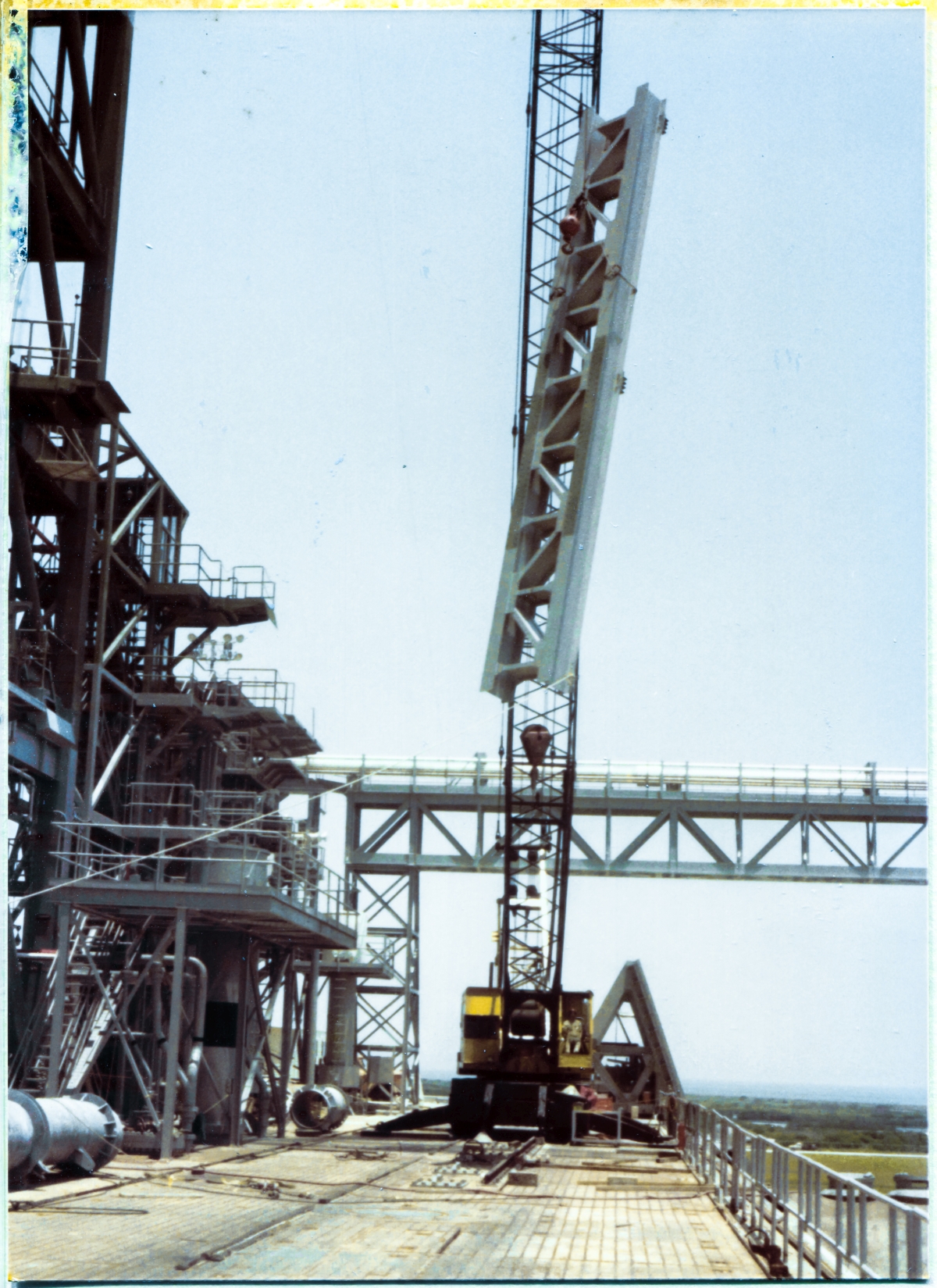
Our Strongback now begins its vertical journey in earnest.
The location for placement of the tag line was at some point earlier determined, and the line was attached, and you can now see where it has been placed. The Strongback still wants to rotate farther around from where it was in the previous image, just a bit, and the slight tension applied to it by the tag line not only prevents it from continuing to rotate, but also fixes is firmly in rotational place, using its innate desire to continue rotating in the direction it wants to, pulling against the tag line slightly, to keep it from backing up on us, keeping it right where we want it. Out of frame, to the left, an ironworker holds the other end of the tag line, and by means of applying judicious tension to it, the rotation of the Strongback is controlled, and for the moment at least, we further see that it has been allowed to continued to rotate, counter-clockwise when viewed from above, and is now resting with the side which will attach to the FSS, facing partially away from us.
No one is on the ground, or any of the structure visible in the image, with the sole exception of the crane operator. It's all in his hands now, and will remain so until the Strongback comes within arm's reach up at the top of the FSS.
On my fixed-zoom camera, I am stepping rapidly away, to the south, keeping both the crane sitting on the Pad Deck and the Strongback in frame.
I'm rapidly getting farther away from the Strongback as I step back from it, and it's also getting farther away from me as it travels higher and higher, and it no longer looks quite as large as it did when it was on, or near, the ground, with people in its immediate vicinity to give it scale.
I always marvel at the psychology of this effect. Things which you know to be quite large and substantial, will, against your better judgment, shrink down in size and significance before your very eyes.
As I continue to back away, over on the left margin of the photograph, the FSS has finally begun to edge into view, extending out of the top of the frame over on that side.
Abutting the FSS to its right, down low, the crazed snarl of steel comprising the MLP Access Counterweighted Flip-ups, the MLP Utilities Interface Platform with its plumbing that sprouts directly out of the Pad Deck and either goes straight up into the Platform or lurches leftwards toward the FSS, the West Elevator and Stair Towers with their own Counterweighted Flip-ups, the 9099 Building with its oddly-bent Blast Cover and ECS Tower Counterweighted Flip-ups on top of it, MLP Mount Mechanism 4, the Lox Tower, and the North Piping Bridge, has come into view, working as hard as it can to utterly confuse and confound the eye of the beholder, and it's doing a pretty damn good job of it, if you ask me.
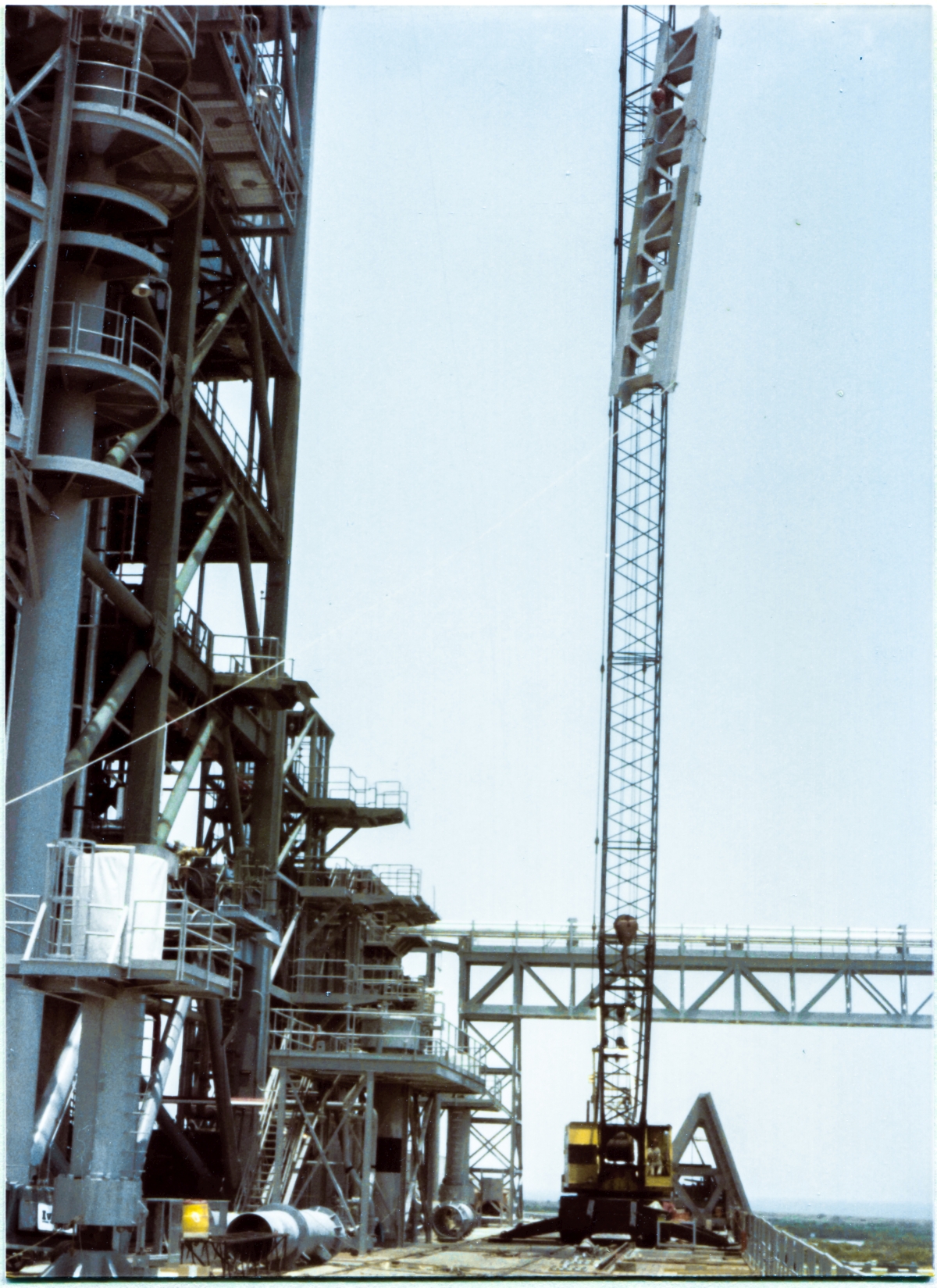
Higher and higher it rises. Smaller and smaller it gets.
Try to remember how big it really is.
Imagine the people we saw around it when it was just off the ground, still nearby, forcing a proper sense of scale to things.
But it's hard to do. Your mind does not want to do it.
And as the Strongback continues to ascend and shrink in size, the FSS is now beginning to grow.
And I continue to step farther and farther back with my camera, continuing to keep both the four-story length of the lifted Strongback, and the Pad Deck, in-frame, and more and more comes into view over on the left side of things, and now we're seeing the bottom of the Hinge Column enter the frame, with MLP Mount Mechanism 6 right next to it down at the bottom.
The Strongback no longer rotates, and is now held steady, right where it is, unchanged in orientation from the previous image, and our unseen ironworker on the tag line continues to give it the the right amount of tension to keep it where it is, right where we want it. For the moment, anyway. This will soon change.
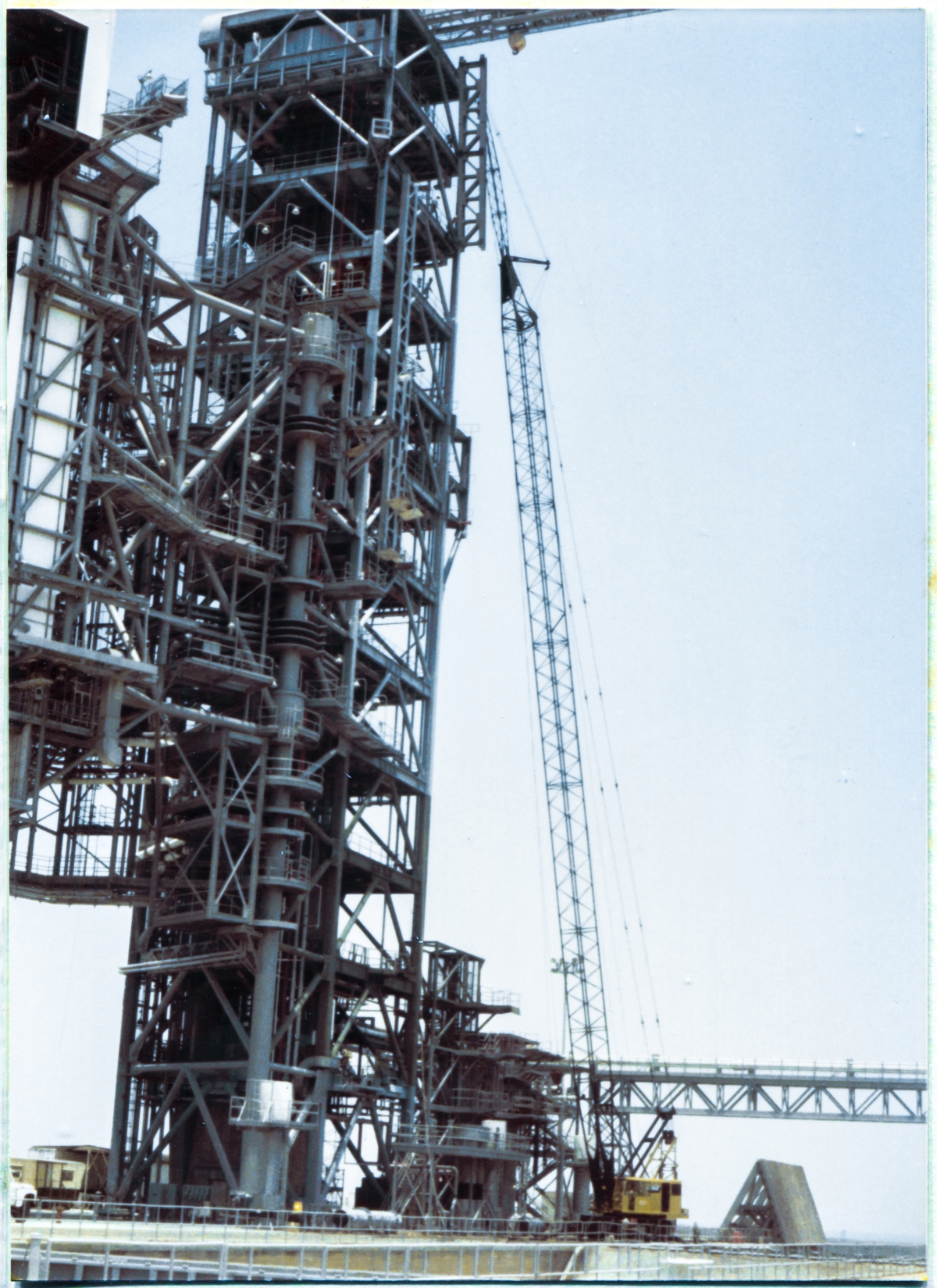
And now the Strongback has reached its destination, but there remains very much yet to do.
To begin with, for understanding of what we're seeing here, notice that the tag line has disappeared and also notice that the Strongback has been pivoted around through almost 180 degrees of rotation from its orientation in the previous two photographs, with its edge that was facing away from the FSS in the previous frames now facing toward the FSS, and it will still need another 90 degrees of rotation, to bring it into face-on contact with the Primary Framing of the FSS and allow it to be connected. The crane boom needs to be kept out of the way for the duration, and this is the only way to do that, even though it looks like they're going at it the long way around, rotating the Strongback much farther than it appears to need rotating.
Right now, the Strongback looks like it's in contact with the FSS, but it's not. It's very close, but it's not quite touching, and therefore continues to remain in free suspension, and continues to be very tractable and easy-enough to continue repositioning.
The tag line was walked around on the ground, and pulled, until the bottom corner of the Strongback it was fastened to swung around until it was facing due south, which means the Strongback was then facing directly away from the FSS, opposite from where it needed to be in the end, but it's also hanging at an angle, and in that orientation, and at that angle, the crane operator can swing his boom around until that bottom end of the Strongback gets within arm's reach of someone on the tower even as the rest of the Strongback continues to slant up and away from the tower, providing full clearance, and once they're hands-on with the Strongback down at its bottom, from then on, they can continue to work things from there, throwing wire ropes on it, and continuing to rotate it, and control it, from that point on, which means the nylon-rope tag line becomes unnecessary, and is removed.
Further positioning continues to get done with wire-rope slings and come-alongs, which are much stronger, and provide the requisite "muscle" to urge the Strongback, which is still hanging at an angle which will definitely need to be addressed at some point, into its final position for bolting and welding to the tower, plumb, square, and true. You'll get to actually see this in the coming frames, but it requires a bit of foreknowledge to make useful sense out of what you will be seeing, so I'm going to be giving you some deeper background on things, first, to allow your eyes to tell you what's really going on.
For the moment, we're not there, yet. We're a long way from it, in fact. And the whole Pad Deck, and everything below the Strongback, remains clear of all personnel except those directly involved with this lift. The life-threatening danger abides, silently hanging in the air like an evil spirit... waiting...
At this stage of the game, I had to run all the way down past the southern end of the Flame Trench, and then across to the other side of the Pad Deck, to get far enough away from everything to keep it all in frame.
The Strongback, that great goddamned big steel monster we were looking at from close range a little while ago when it was hanging just above the Pad Deck with a group of ironworkers around it giving us proper scale, has now shrunk down to this tiny little thing, dwarfed into insignificance by the jaw-droppingly colossal size of the FSS it's being attached to.
That goddamned FSS was BIG, and it's impossible, really, to convey the true size of it, but this series of images, when considered, at least makes a few small inroads on conveying its actual size.
And the RSS, of course, is right there with it, is equally colossal, and is equally impossible to convey its true size.
And while we're here, maybe give the image a looking over, disregarding the Strongback lift, and instead just taking in the wholeness of the structure.
The Hinge Column is well-displayed, set against its labyrinthine background of steel framing and encircled by all of its crossover and access platforms.
The whole system of Rotating Crossover Platforms, for its entire vertical extent, which we first encountered way back on Page 6 as part of our "HFL 100-211" is as well-displayed as you'll ever see it, although, as you move away from the front side of it which is facing the camera, hangers, beams, diagonals, and platforms, moving deeper into the shadows toward the rear, away from the camera, it becomes progressively more and more difficult to pick all that stuff out from the hurricane of other intervening and surrounding steel it's embedded within, but it's all there, and if you harbored lingering doubts about any of it, perhaps this image might be of some small use in allowing for additional understanding.
Down toward the bottom of the Hinge Column, below the lowest part of the HFL 100-211 stuff, you're also getting a really good view of how the Struts work, extending over to the FSS in two directions on either side of the Hinge Column, making up part of FSS Side 1 (on the right side), and defining FSS Side 5 on the other side (the left side). We just finished up with quite the bellyfull of FSS Side 5, doing the Centaur Porch and Platform on Page 62, and in this photograph it's easy to see how the Side 5 Struts comprise heavy horizontal members with equally-heavy chevron-shaped diagonals having top "points" tying to the underside of the midpoints of the horizontals, while the Side 1 Struts, which span a shorter distance, are more simple, with the heavy horizontal members braced diagonally with single, slanting, cross-pieces, instead of "chevrons." And of course, just to spice it up a little, not all of the Side 1 "horizontals" are precisely horizontal, and some of them get kicked off-level in the areas above and below where everything has to yield right of way for the Hinge Column Lower Bearing, which rotates, and which cannot be tied directly to, with the immobile Struts. This also applies to the Side 5 Struts, but the area where they also yield right of way to the Bearing is completely hidden from view, so you can't see it in the photograph.
At this point in time, no Centaur on the tower had begun, and you get a pretty clear view of where it's all going to be put, just a smidgen below the level of the Hinge Column Lower Bearing Lower Service Access Platform, out there through the Struts, Platform, Porch, and all.
There is much else here that is about as well-displayed as you'll ever get, informatively viewed from a very useful angle, but I'll not get into the listing of it all. Too much. Waaay too much. And we've already visited this stuff in these essays before, anyway. You already know all this stuff, right?
Ok. So what's going on here with our Strongback right now?
What does our photograph have to tell us.
Click on the damn thing.
Render it full size.
Maybe even zoom in on it some more, from its already full-scale size.
Look at the bottom of the Strongback. Look at the levels of the FSS directly adjacent to it, and above and below it, too.
The bottom of the Strongback is at Elevation 260'-0", and back away from the Strongback a little bit, our white-shirted yellow-hardhatted ironworker is focused on where the Strongback comes in contact with the FSS, and there in that little corner, mostly obscured by one of the Primary Framing Pipe Diagonals which meets the FSS Perimeter Column over there next to the bottom of the Strongback, is Rink Chiles, yellow hardhat, blue shirt, and he's bent over, hands-on with something. As an aside, Rink was never afraid of getting his hands dirty, and this was one of the reasons he was such a good general foreman. He never asked anybody to do anything that he himself would not pitch right into at a moment's notice if need be, and on top of that, he was very likely quite a bit better at it than they were, anyway. People respect this sort of thing. People who are afraid of getting their hands dirty, who think doing so somehow reduces the "high station" which they believe themselves to occupy and thereby makes them look less "important" can very easily become managers. But they can never become leaders. Maybe make a note of that for future reference. People are watching you. All the time. And they're constantly measuring you while they do, and keeping a book on you about it, too.
Ok. So we've located Rink, kind of hanging over that pipe diagonal. Now look to his right, at the second-to-last horizontal bracing member running between the twin W24's of the Strongback. Not the one down on the very bottom, but the one just above it. The horizontal one. Ok. What's that hanging down from it there? Looks like a wire rope, tied around the horizontal bracing member, extending leftwards toward the FSS, where it disappears against the darker background there at what I would call knee-level with Rink. Pay attention to that wire rope. It's important. We're going to be using it.
Notice also, directly beneath Rink, on the same steel he's standing on, the bottom weldment which attaches the Strongback to the FSS is visible, already welded in place, and as confirmation, its corresponding location at the bottom of the Strongback is facing nearly directly at us, in plain sight, and bears no resemblance to the two other attach weldment locations on the Strongback, one in its middle, and one at its top, which, in complete agreement with what we've already seen from much closer range down on the Pad Deck, do have their connection weldments already attached.
Go back to 79K24048, sheet S-107 and look at Section C and Detail K to see that all three of these attach weldments get welded to the tower, but bolted to the Strongback, and I'm guessing this was done to allow the goddamned thing to get fastened to the tower in the first place (if you can't even get to where a weld needs to be laid down, then you're not going to be doing any welding, whether somebody else needs you to or not), and Ivey Steel separated the bottom one from the Strongback and welded it to the tower in advance, to give them something to pin it to once it was up in the air, allowing them to fix it precisely in place prior to welding it down. That's a surmise however, and I was not directly involved with any of it, and I can never know for certain. But I'd still be willing to bet a little money on it, anyway.
Above Rink, at Elevation 280'-0", somebody (again, partially obscured by the pipe diagonal) is keeping a close eye on things up there, and down below, at Elevation 240'-0", another ironworker watches the bottom side of things which Rink cannot see, and is leaning out over the handrail a little bit, a little dangerously, the better to see clearly, and also the better to be able to shout information up to Rink if need be. Whoever he is, he's a Union Ironworker, and he's working for Ivey Steel on a critical lift, which means he's as good as they have down at the Union Hall, and they don't come any better, and he's allowed to do this, and he does this kind of thing whenever he needs to. You and I are not, and don't ever do shit like this, whether somebody "needs" us to or not. And on the very top of the FSS, almost completely obscured by the top of the Strongback, yet another anonymous ironworker, or perhaps even Wade Ivey himself, is visible, just barely, just the tiniest dark smudge against the bright sky, down in the bottom of the sharp corner formed between the top of the Strongback and the FSS Side 1 Perimeter Framing Steel. Be advised, there is no handrail up there on top of the FSS at Elevation 300'-0", and all you get up there is 4 inches of steel toeplate all around, set back six inches from the edge, and that's it. So. You'd best know exactly what the fuck you're doing up there, lest something befall you.
Ok, that's quite a lot to be making proper sense of all in one go, so I've gone ahead and labeled up the photograph showing the Strongback at the top of the FSS, to let you better see exactly what the hell I was just going on and on about. Pay closest attention to the stuff up at the top, where the work's going on, 'cause we'll need to understand where we are now in order to understand where we're about to go. Take your time with it, nobody's in any kind of hurry. Savor it even, if you can.
At this moment, things are being arranged so as the Strongback can be worked into its final position, face against the FSS.
There's a lot going on, getting everything ready for the next steps in the process, and there's nothing more I can do for you photographically on the ground, so now I need to hotfoot it up to the top of the tower, to let you see how the final arrangements involved in getting the Strongback attached to the FSS were done, and some of it is pretty scary-looking, but it's Union Ironworkers, and they're good to go, even if it makes your stomach turn, just to look at it.
So let's head on over the the base of the FSS down on the Pad Deck, and get in the elevator so we can take a ride up to the top, but before we get in the elevator, whatta ya say we take a delightfully dangerous detour, for just a few moments, and snag one more frame from down here at "ground" level.
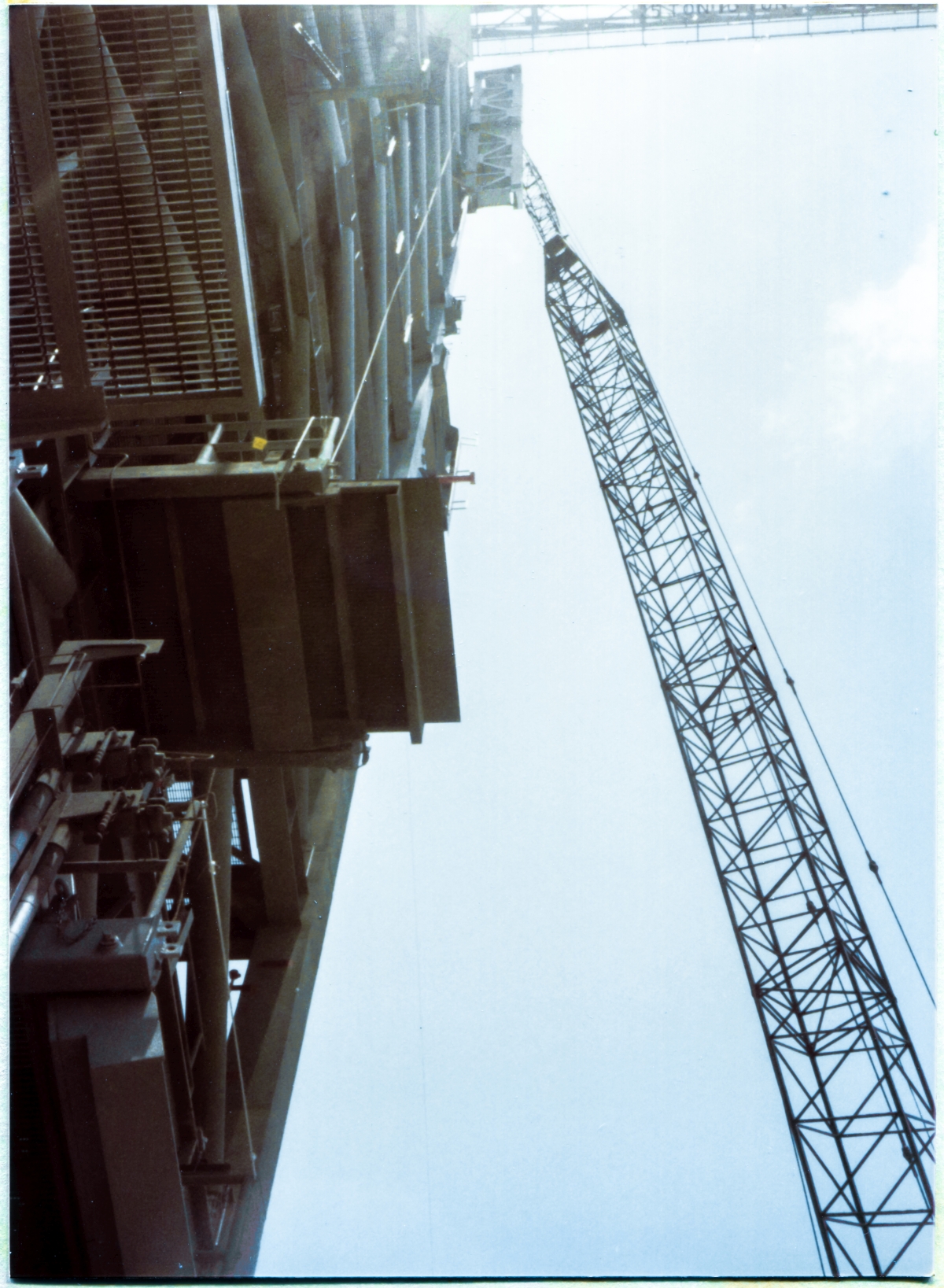
Don't do this, ok?
Don't EVER do this, ok?
'Cause it just might wind up being the last thing you ever did.
I'll copy the 'alt' text for the photograph, verbatim, sprinkle it with just a little bit of emphasis here and there, and drop it into this page thusly: "GOX Arm Strongback at its final elevation at the top of the Fixed Service Structure at Space Shuttle Launch Complex 39-B, Kennedy Space Center, Florida, viewed from directly beneath it, just outside the perimeter envelope of the FSS on Side 1. You're bent way over backwards, trying to hold your camera pointed straight up, while squinting through the viewfinder composing your frame, and it's disorienting, and it makes you want to topple over and fall flat on your ass, and properly centering the goddamned frame turns out to take a lot longer than you want it to, and meanwhile, far above your deeply-stupid head, Death stops for a moment and considers you, and decides whether or not it wants to take you, and before it has a chance to decide it does, and then do so, you hit the shutter release, snatch the camera back down away from your eye, and get the hell out of there on your fastest legs, to safety beneath the main structure of the FSS where falling objects cannot get you."
This is one of the stupidest photographs I've ever taken in my life, but it's also one of my lifetime favorites.
The moment presented itself, I seized it, and I lived to tell about it, and by god, I'd do it again, too.
"Don't stand underneath a suspended load."
And that goes double when there's people working the load. When there's people anywhere near the goddamned thing.
I recall a story told to me by one of the older ironworkers, who had worked erecting the steel for the VAB (which is over 500 feet high) in his younger days, and he said that he was on the ground, with a buddy, sitting down eating lunch, leaning against a column, and with zero warning, not a sound made in advance, no sign of any kind in advance, a large structural bolt plummeted into some dirt right next to them, inches away from them, with a loud THUD.
By which point there was nothing in the world that either one of them could have done about it, and so they simply exchanged looks and a few low swear words, got up, moved a little farther away, and went on eating their lunches.
The bolt, had it found either one of them, probably wouldn't have gone quite all the way through them, but it would have gone plenty far enough.
I was further told that they never did manage to see who it was that was up there, or exactly where the bolt may have originally come from, or how high that might have been, and the imponderables multiply into chaos pretty quickly with a thing like this...
Was it some one? Or was it some thing?
Did somebody simply drop a bolt?
Did an unfastened bolt simply fall out of something that got turned over?
Or was a bolt, lying on something, maybe not even very close to the edge of something, dragged off by someone, possibly much farther away, dragging a hose, or a rope, or an electric cord, or a tethered object, or...
There can never be a way to know.
And did it come directly down at them?
Or had it ricocheted off of something part way down, but still far enough above to remain silent to those who wound up beneath it, and kicked off significantly to the side irrevocably concealing the original resting point it was dislodged from?
Who can know?
"Don't stand underneath a suspended load."
And while you're at it, don't stand in an exposed location underneath a place where there are people up above, people who are working, people who might cause something to go a little off course at some point.
And yes, my head was filled with such thoughts as I... didn't quite grit my teeth... but it took a determined effort of will... and I entered the zone...
And I got my goddamned photograph...
But it's not like I didn't know where I was when I pulled the shutter release.
And I've already said I'd do it again, because this is a spectacular photograph, and I had a feeling it would be, and by god it really is.
The Strongback hangs in the distance far above, still tilted, with its top farther across toward the centerline of the FSS than its bottom, and it's literally so far above me that it has been dimmed by haze, and its shadows are not nearly as dark as the shadows below the counterweighted flip-up platform at Elevation 100'-0", forty some-odd feet above my head, intruding as a dark rectangular object almost all the way into the center of the frame, from over in the middle of the left-hand side.
The FSS exists as a Great Precipice, blotting out the left side of the image, leaning darkly and oppressively into the frame farther and farther, the higher you go, and the Hammerhead Crane cantilevers outward from its summit to the right, more a part of the sky than the Earth, bracketing the top of the frame perfectly.
Extending down at an angle from the Strongback, all the way to the lower right corner of the frame, the black latticework of the crane boom balances the composition perfectly, and adds a visual dynamic, drawing your eye back to the Strongback, hovering far above you, suspended by a single iron thread, deeply-threatening, but somehow beckoning you to it at the same time.
And if all that's not enough, click the image.
Render it full size.
Look close at the sliver of brilliant daylight between the top of the Strongback and the Side 1 Perimeter Steel of the FSS at Elevation 300'-0".
There you will see a human. Silhouette spanning the sliver of daylight in two places. One, above, thin and indistinct. It's an arm. The other below, just a bit, heavier, more distinct. The person themselves. Working the Strongback.
250 feet above certain death they hang. 250 feet above the fool holding the camera directly beneath them. Insignificant to the point of near invisibility, contrasted with the vast construct which they're in the process of adding to, giving scale to the whole thing in a way that nothing else could.
Yeah, this is a good photograph.
This photograph belongs in a fucking Art Museum.
Or an Art textbook.
Based solely on form alone. Simply on abstract form alone, stripped of all meaning, this is a good photograph.
Spare, near colorless, only the lights and the darks to speak to you.
And then you add in the actual story that it tells. Add in the people. The things. The scale and distances.
And the photograph simply becomes that much better.
So yeah, I'm glad I took it.
I'm glad I entered the zone and took it.
And I'd do it again, unhesitatingly, were the opportunity to somehow return for me to seize it once more.
Very well then, to the top of the tower.
To the end of the Hammerhead Crane Boom.
To hang ourselves out past the edge of the catwalk, untethered, no safety harness or line, beneath the horizontal bars of the handrail.
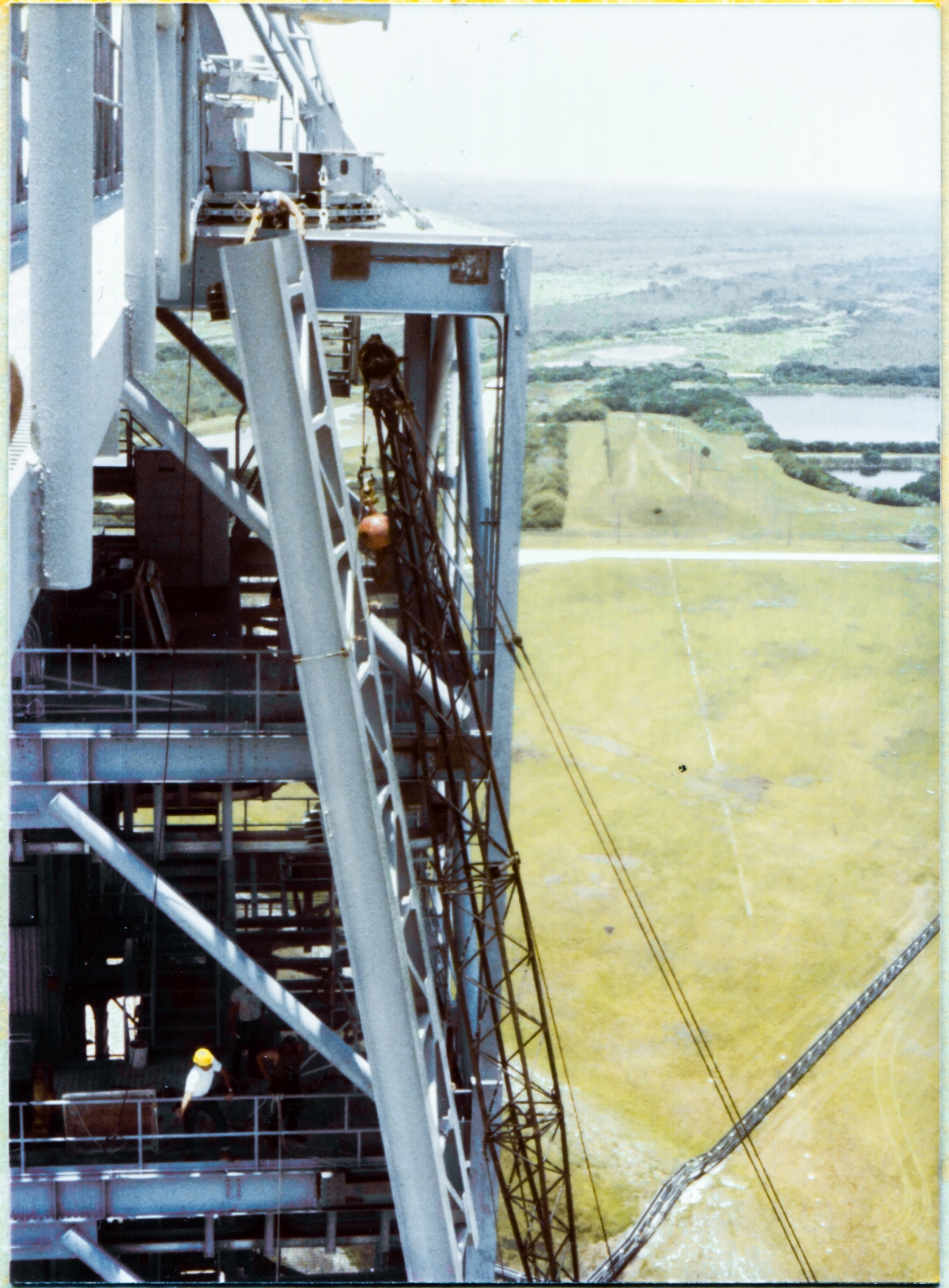
And here you can see from eye level what was going on in the haze-shrouded distance in the previous image I took from the Pad Deck.
The Strongback remains tilted over, with its edge to the FSS, and that's going to have to change significantly in order to connect it.
This is another pretty dramatic shot, and it was pretty dramatic taking it, too.
And I'm gonna stop and spend a little time describing the taking of the photograph. People always ask me about that kind of stuff, and the more dramatic the image, the more I get asked, and no I wasn't involved in any of the actual work, and no, I was never an Ironworker, and could never hope to operate at the stratospheric level which those people operated at on a routine day-to-day basis, but yes, I was there, and I did scramble out on the iron a time or two, and even though being on the catwalk can never be considered being out on the iron, I did have to contort myself a fair bit to get this image, and in so doing managed to negate a lot of the beneficial effects of having a proper catwalk holding me up, complete with steel-bar grating and handrails, so... ok.
So where am I? Exactly.
Look at the top margin of the photograph, and hanging down into it, a little left of center, is a gray squared-off shape that partially obscures the framing that comes up off of the Hammerhead Crane's wheeled turntable (no, that's not what it's called, but that's what you're seeing, so that's what it is right now) heading up and to the left, clearing the darker curved shape of the Crane's "Cab" (nope, not that either, except now it is). That squared-off shape hanging down into the frame is one of the three big Lights attached to the Crane Boom, and is in fact the one farthest out toward the end of the Boom. Out where I'm laying down, beneath the handrail, just above the steel-bar grating, taking my photograph.
Below and to the left of that Light, the other two can be seen, and they're rectangular too, but they also have junky stuff on their tops and sides, where they bolt on to the handrail that runs along the Catwalk, which itself runs along the full length of the Crane Boom.
So ok. So I'm out past the third Light.
And where might that be?
Well... we can look at the Crane Boom from the opposite direction, see where that third Light is, and that tells us pretty much where this photograph was taken from.
And here's what that looks like, and it look familiar because it's the lead image for Page 35, which you've already read. The Lights are pointed out, instead of directly down, but yeah, it's the same stuff, in the same place.
So yeah, I'm as far out there as you can get, without going past the end of the Catwalk.
It's all about the frame and with a fixed-zoom camera, you do whatever you have to do in order to fit things into the frame properly, and when you need to get farther away to do that, well then... you get farther away and do it.
But of course, just getting far enough away, may or may not fully solve your framing problems, and if there are other things out there that are in the way, blocking the view, keeping you from properly documenting your chosen subject, then additional steps have to be taken. If they're possible, of course.
And out there standing on the end of the Catwalk, trying to get the face of the FSS beneath me into the frame, I was blocked, 'cause... well... I'm standing on it, and it's not only directly underneath me, but it's also a little to both sides of me, and the goddamned handrails are sticking up into the air, blocking even more, and...
This shit's gotta go, and the only way I had at the time, to make it go, was to move my eyeballs, with the camera plastered right in front of them as I squinted through the viewfinder, someplace where there wasn't going to be any Catwalk, or any handrails, in the goddamned way, blocking my view.
Which involved a little contorting, as I laid down on the steel-bar grating (not the most comfortable bed you'll ever find to lay on, I can assure you), leaning with my head, shoulders, and some of my torso out over the 4 inch high steel toeplate (yeah, that one's a little uncomfortable, too), underneath the handrail where it wasn't in the way, nor could I touch it or otherwise use it for proper support, safety, or moral encouragement, and I was down laying on my right side, sort of, and I'm kind of wriggling farther out above the abyss beneath me, working to a point where I could feel myself starting to overbalance, wanting to tip farther over and down, past the material that was holding me up, and the camera is on a leather strap, but I never trusted it, and I'm kind of holding it with my right hand, wriggling along, feeling that dreadful overbalance point growing closer and closer, the farther I tried to get the damned camera out past the Catwalk and handrail, and I didn't really have the use of my hands anymore, so if something was to let go, I'm not sure I would have been able to latch on to anything to prevent it anyway, and god DAMN but this is some scary shit out here, and I do not like being where I am at all, but nobody else seems to be paying me any attention as I stupidly writhe around on the end of the Catwalk like a wounded snake or something, but hey looky here, I can SEE, so hit that fucked-up shutter release already, and wriggle your sorry ass back in there on to solid steel before something bad happens to you.
And so I did, and so you get to see the photograph that resulted from all of that exertion mixed with a healthy dose of stupidity.
Look close at the photograph, and over there on the left margin, about a third of the way down from the top, darkly silhouetted against the bright background of the Catwalk grating, you can see just the weenciest brown curving bit of the left side of my left boot heel, foot aimed downward, inadvertently included in the frame.
Maybe measure across, over at the FSS where James is, to try and get a sense of just how far I'd managed to cantilever myself out there, away from the safety of the Catwalk, and you start to realize...
Damn... that fucking idiot is... out there.
And yeah, I was.
Hands-free, no safety gear, no nothing.
So ok. So I'm not an ironworker.
But every once in a while...
Alright, enough of that bullshit, what's going on with the Strongback. We're here for the Strongback, right? Screw the stupid photographer. Nobody cares about him anyway. Let him die. Just make sure he gets the picture first, ok?
Ok. Right off the bat, we get an immediate answer to why they used that whack-ass lifting sling, not attached to the top of the Strongback, and not attached to the crane's lifting hook.
And that reason is...
...sly...
...and exemplifies, perfectly, how the mind of a successful steel erector works, and, as with Cecil Wilhoit, Wade Ivey was very much a successful steel erector.
Money.
Underneath it all, you find that you're dealing with money, and if you're very clever in your dealings with money, you get to come in low-bid, get the job, work the job, and get the hell out of there, at, or even under budget and perhaps ahead of schedule, too.
And you attack all things, great and small, as opportunities to spend less money, take less time in the doing of, and continue marching down the road, getting more jobs, making more money, and keeping your business afloat while you do so.
And one of the things that comes in as a significant budgetary item is crane rental (nobody really owns their own cranes in the steel erection business, 'cause that's not cost-effective because the crane would sit around for longer periods of time than are desirable, not making money, so it's cheaper to just rent the damn thing for only those times when you actually need it, and then get rid of it when you're done with it), and cranes are expensive on a per-hour basis, and grow more and more expensive, the larger they get, and the longer the boom you put on them gets.
So anywhere we can cut back on our crane rental costs is a good place to save money.
And now go back to the photograph above these words, and take a look at where the tip sheave on that crane boom's jib is located.
It doesn't even make it all the way to the top of the FSS!
We're hanging iron up at the top of the FSS, and our crane won't even reach!
How the fuck does a thing like that even work?
Well... you're looking directly at "the fuck does a thing like that even work" in the form of that daffy lifting sling hanging down ten feet, give or take, below the top sheave on the jib to where it's attached to the Strongback, a smidgen under sixteen feet (go back and look at 79K24048, sheet S-107 again and figure it out for yourself, I don't feel like holding you by the hand with it anymore) down from the top of the Strongback, and by golly, add those numbers up, and you discover that you've got just enough margin to make it work, and you did it with a cheaper crane, and we're not going to even get started on how much money Wade saved by not having to take the crane out of service, lay its boom down on the pad deck, take it apart, insert another Boom Segment (that itself did not come for free and which took it's own bite out of the schedule and budget by forcing people to stop what they were doing on the tower, go down to the Pad Deck, and rig the fucking thing to the crane, with additional Boom Pendants and all the rest of it), and then re-rig the actual Lifting Gear for this lift, and this lift alone, doing it a different and most likely no-faster way.
I can only imagine what it must have been like when Wade and Rink were together, working this one out in advance, trying their utmost to find the hidden flaw in their reasoning, trying to figure out why this was a Bad Idea, coming up with nothing, and finally looking at each other, shrugging their shoulders, and saying, "Ok, let's do it."
Ballsy. Very very ballsy move.
And it worked.
And speaking of working, what the hell is James Dixon doing up there on top of the FSS at Elevation 300'-0" in an area with no handrails, down on his knees, bent out over certain death to an alarming degree, hands-on with a thing that weighs 12,000 pounds?!
And what he's doing is that he's reorienting it, rotating it around a little farther towards its final configuration with its face against the FSS.
Remember, it's not quite touching the FSS, and is free as a bird to be persuaded to come on around, farther and farther, not all the way, but a decent piece of the way, and so long as James doesn't slip, or suddenly lose his grip in a lethally-awkward way, he'll A.) stay alive, and B.) get the damn thing worked around to where they can really go at it, with a come-along, applying main force to it as they do so, even as they get it finish-located to exactly where it needs to be.
Down at the bottom, down at the other end of the Strongback, look close and you can definitely see a bit of that wire rope on the second-to-bottom horizontal bracing member I was talking about earlier, and even drew an arrow to on the marked-up version of our previous photograph where you could see the whole FSS top to bottom, with the Strongback edge-on to it.
That wire rope is on there, but right now, it's not doing too very much of anything, and the Strongback still has plenty of slack down there to allow its bottom end to wind up farther and farther away from the FSS, as its top end, remaining in near-contact, or even light-contact, continues to pivot around farther and farther toward the northeast corner of the FSS, the Side 1/4 corner, where it's gonna wind up being pretty damn close to in the end.
Elsewhere, one level down from James, at 280', you can see just a bit of Wade Ivey, from his right shoulder down, standing back from the handrail a little bit, with the rest of him obscured behind the slanting gray shape of the Strongback. His attention is fully focused on that lifting sling where it's attached to the Strongback, directly in front of him and just about eye-level, watching it like a hawk as things continue to move around, making damn good and sure it's not showing any signs of wanting to reposition itself, or otherwise permit the Strongback to... go someplace. We are still, in too many ways to enumerate, very much in life-threateningly-dangerous territory. If something goes wrong here, it's going to be going very wrong indeed, and everybody involved, from the owner of the company on down, is on that shit.
Below that, down at 260', it's... interesting.
We have our anonymous white-shirted ironworker giving hand signals to the crane operator far below him, who is unable to properly see exactly what's going on here, utterly dependent on the accuracy and situationally-dependent appropriateness of those hand signals to get the iron where it needs to go, with pinpoint accuracy. Everybody's lives are well and truly in the hands of everybody else, and the entire web of trust stands or falls, completely dependent on the competence of every single member of the group, no individual one of which can be allowed to fail, lest that failure cascade with horrifying speed into a full-fledged catastrophe.
Serious business. Serious serious fucking business.
Behind, and a little to the right of our hand-signaler, a figure in a white shirt and dark pants, head obscured by the big pipe diagonal, can be seen. Looks like he might be holding a rolled-up sheet of paper in his right hand.
I'm not sure who this is, or what he's doing up here, but his posture and location gives me to think that he's not one of Ivey Steel's people, and instead might be somebody else's quality guy, or safety guy, or some other contractor's watchdog guy, or craft labor union representative guy, or NASA contract management guy, or engineering support guy, or... any number of other "guy" people. Any one of which could be a "girl", needless to say, but back in the early 1980's, women were woefully underrepresented in places like this, and while we're at it, we may as well go right on ahead and acknowledge the heartbreakingly uniform whiteness of everybody involved, too. It wasn't completely segregated by gender and race everywhere, but it came pretty fucking close, and that end of things always distressed me, and yes, things seem to have improved somewhat over the intervening decades, but god DAMN it, it's still way out of line. Waaay out of balance. And I don't like it at all. Not one little bit. Sigh.
Regardless, whoever this person is, he constitutes somebody's pair of eyes, in-place, as it was all going down, and for whatever unknown and imponderable reasons, he was deemed necessary, whether to see to it that something was caused to happen, or something was caused to not happen, or to just stand as competent witness to whatever the hell it was that did happen, and people like to make fun of everybody who stands around while workers are doing the work, but if the shit ever hits the fan just so, and it turns out that you didn't have one of your "guys" right there when it did... woe unto you. Grievous grievous woe unto you. So yeah. You put your guy there, and he fucking stands around while everybody else works, and with luck, that's all that ever happens, and it turns out that things would have gone along just swimmingly without him. But. Sometimes they don't.
And who, or what is that over there to the right of our white-shirted hand-signal ironworker?
Bring it up, full resolution, maybe even zoom in on it a little from there.
I mentioned "Death" turning its attention momentarily my way when I was down on the ground, beneath a suspended load, taking a photograph, so... is this maybe Black-hooded Death? Standing around bare-armed, completely invisible to everyone, but showing up on my exposed film for some strange reason, maybe feeling a little bad about not getting me before I hightailed it out of there, looking around for its next opportunity?
I kinda doubt it, but... you never know, right?
My guess is that it's one of our ironworkers, putting on a leather welding apron, maybe with a welding hood on his head, not pulled down, sticking out above and in front of his face obscuring it, head-down just a trifle, similarly dark as everything else in his attire, eliminating all contrast that might serve to better limn his actual form... but who knows?
There's definitely going to be a float hung over the side right here, giving somebody good access to the bottom end of the Strongback once it's in its final position, but beyond that...
No idea what's going on with it here.
None at all.
And of course I lied about coming to my senses and returning to the solid steel safety of standing directly on the Catwalk between the handrails after taking this shot, because of course once they'd pulled and rotated that Strongback around the rest of the way (which took a pretty good while, this stuff does not happen fast), I skoonched back out there under the handrail and did it again.
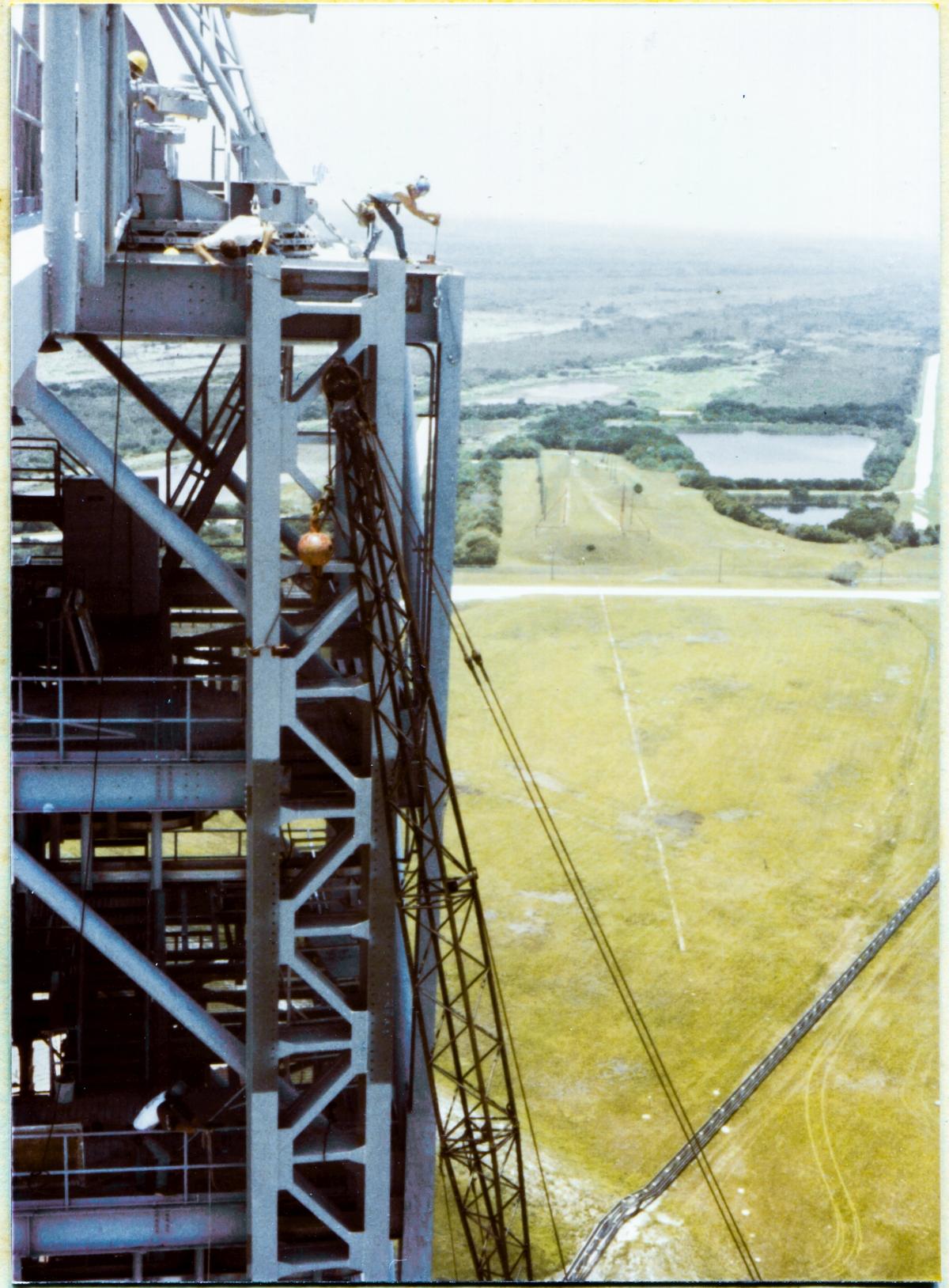
And how long might that have been, between my wriggling back to safety, and then near-suicidally skoonching back out under the handrail a second time in order to get this shot?
Well... I cannot give you any sort of stopwatch time, but I can draw your attention to the light and shadows created by a blazing midday sun, shining down on Side 1 of the FSS, the side facing the camera, which runs exactly due north to due south. In the previous image (number 078), bright light illuminates the flange edges of the FSS Perimeter Beams, and also illuminates the tops of the big Pipe Diagonals which run between levels at an angle.
"Local noon" had not yet occurred, and the sun was still a trifle east of the meridian.
And in image 079, directly above these words, that is no longer the case, the sun has crossed over the meridian to its west side, and the Side 1 Perimeter Beams and Pipe Diagonals are now solidly shadowed.
Precisely how long between photographs, I cannot say, but clearly, enough time had passed to allow the sun overhead to move. So. Didn't happen right away, and I was out from under the stupid handrail for a decent bit of time before I decided that it would be a "good idea" to get back out there, cantilevered above the abyss, and grab another frame.
Ok, fine.
What's going on with the Strongback? Where are we now?
And where we are now is on the home stretch, bringing it in.
The Strongback now faces more or less directly away from us, face to the FSS, and it's now in hard contact with the FSS up at its top connection point, where its attach weldment is now scraping along against the web of the Perimeter Beam at Elevation 300'-0", as James Dixon urges it ever northwards with a come-along, homing in on its final location where it will be finish bolted and welded to the tower.
Careful scrutiny is being given to things by our unnamed ironworker in a white shirt looking closely into the area between the top of the Strongback and the FSS Perimeter steel.
Rink Chiles has walked out on the Hammerhead Crane Boom just far enough to give him a clear look at where the Strongback meets the FSS too, yellow hardhat visible above and to the left of the two large downpointing lights outboard of the handrail on the Boom.
At this moment, the Strongback is not only still a little off-location with its rotation and orientation, but it's also a little off-location low. The crane operator is not yet done with giving it every last inch of the elevation it will need for final attachment to the FSS.
Between the taking of this frame, 079, and the previous frame, 078, James Dixon wrapped a loop of wire rope from a come-along around the top of the Strongback, which was then threaded across to a snatch block of some kind that was secured somewhere over there to the "roof" of the FSS (Nobody ever called it the "roof" ever, it was always the "top" or maybe "elevation 300" or just "300" or even "the hammerhead crane" but whatever it may or may not have been, it was never the "roof" ok?), and which is hidden from our view behind the Strongback, taking the wire rope from there, across to the come-along which James is working with a handle to increase the force he can muscle into it, which is hooked on to something else we cannot see, hidden behind the toeplate, at its far right end, and he's brute forcing the unwilling Strongback into position with it.
This is the exact same technique for moving insanely-heavy objects without the use of any wheels or other conveyance of any kind, which I dumbfoundedly encountered for the first time when I was still as innocent of all of this as a babe in the woods, brand-new on the job as an answering machine working for Sheffield Steel, when Wilhoit brute-forced the entire Bottom Truss of the RSS across five lines of Falsework, back in 1980.
And now that we've come this far with our lift, and have learned as much as we have about the ironworking, and the engineering, and the physics, and the culture, and the art of lifts, I'm going to completely interrupt the narrative right here, and throw us backwards in time, all the way back to Page 8, back to the first half of 1980 when I was still an answering machine, and we're going to learn about how Wilhoit lifted 160 feet of RSS Bottom Truss, in one piece, weighing 150,000 pounds, eighty feet straight up, and laid it down on top of the Falsework they'd already emplaced for the purpose of erecting the RSS.
You are only now considered knowledgeable enough to properly understand, the beyond-belief RADICALNESS of what Wilhoit's Union Ironworkers did that day, as I sat in Sheffield Steel's field trailer, waiting for a phone to ring that never did, staring out the sliding glass doors over the roof Wilhoit's own field trailer which was located right next to ours, dumbfoundedly watching what happened that day unfold, utterly unable to comprehend what it was that I was seeing, but at least possessed of enough innate sense of scale to be completely overwhelmed by what I saw, eyes riveted to it for the full duration of its prosecution, which took most of a full work day to complete.
Radical. Fuck ing radical.
It's been a long time.
And not much has survived.
And the idiots who should be most eager to preserve these hard-core exploits from their own past turn out to be the least trustworthy bastards of all, can be relied upon to either simply let things disappear without a trace, or even actively seek to hasten those disappearances, and at the top of that List of Bad Guys sits NASA themselves, and the Smithsonian National Air & Space Museum, both of whom, you would think would really like to be able to tell more ripping-good stories, to more people, about the radical shit that went down in days of yore, but if you were to think such a thing, you'd be wrong.
They either don't give a fuck, or are actively working, shovels in hand, to bury it. People who literally cannot see past the boundaries of their own narrow office walls have been put in charge of preserving the history of, or not preserving it, things which are so large, and so significant, that they literally cannot even sense their presence. This is an ongoing tragedy and the day will come when their ruinously short-sighted decision-making processes will be rued deeply, to the sound of a great gnashing of teeth, far and wide, high and low. Mark my words. That day is coming.
But not everything is gone.
Not quite yet, anyway.
And I've got a few tattered scraps of my own that I've found, which I can add to the first-person tale I can tell, as a first-person witness to the events that went down that day.
Wilhoit went up with the Falsework on the bare concrete surface of the Pad, immediately south of the Fixed Service Structure they had just finished constructing per 79K10338, which was made out of repurposed parts of the LUT which was the tower portion of Apollo Mobile Launcher 2. That Falsework was being readied for the erection of the Rotating Service Structure at Pad B, which was constructed per 79K14110.
And while Wilhoit was going up with the Falsework out on the Cape, Sheffield Steel was balls to the wall on the shores of the St. Johns River, in Palatka, Florida, fabricating all of the steel which would be assembled together into the RSS. Four million pounds, give or take. A lot of steel.
And we just learned that steel erection in general, and lifts in particular, are as much art as they are anything else, and one of the great strengths of artists consists in their astounding creativity, as expressed in combining things that everybody else is well aware of, and are in no way unique or otherwise "special", and by combining common-enough things in a unique way, they can produce arrestingly outré objects and actions that nobody else in the world could possibly ever have thought of on their own, and in so doing, cut right through things that form solid barriers that everybody else is unable to pass beyond.
And Cecil Wilhoit was an artist.
A highly-skilled and extraordinarily-creative artist.
And an especially-creative facet of his art form was the business of getting steel wherever it needed to be gotten, be it easy or be it "impossible," as part of his other tasks associated with the construction of large and complex objects built principally from steel.
Which the RSS at Pad B was a shining example of.
And which Cecil was better at than anybody else when it came to finding creative ways to use mundane-enough things to achieve exceedingly high-level and high-efficiency (Read: For much less time and money.) results, on a regular basis, pretty much leaving everybody else in the dust as he did so, back there scratching their heads wondering just how the hell did he do it again, this time?
And you've got a little bit of open space, but not much really, because the Pad Deck is hemmed in by the Flame Trench on one side, and the Pad Slope extending around all the other sides, and you're going to be chewing up most of that already-small allotment of space with the Falsework that you're going to build your Rotating Service Structure on top of, and you've got a couple of common cranes, largish perhaps, but certainly nothing unusual or specialized (Read: Expensive.) about them, and you first have to construct your home-made scrapyard Falsework to lay stuff on top of before that stuff can become self-supporting, and how might you... creatively... get it all done... high-level and high-efficiency? ...using more or less whatever's laying around, to do it.
And my understanding is that none of the other bidders at the time were able to conceive and execute what Cecil Wilhoit wound up doing.
"Nah, you can't do that. You'll kill yourself. You'll kill everybody on the jobsite. You're gonna turn a crane over, kill everybody, destroy the whole Launch Pad, and set the Space Shuttle Program back literal years when you do it."
"Nah, you can't do that."
And that's how everybody bid it.
Except Cecil.
Who of course came in low, got the job, and did it.
The best way to save money on steel erection is to minimize, to the greatest degree, the amount of time spent assembling things. The amount of time spent connecting things. And the first rule of saving time connecting things is to do so on the ground, where it's vastly easier to access and manipulate things than it is up in the air.
I'm not going to get into why with this one, you should have developed enough of a gut feeling for things by this point that a statement like that should be so obvious that it does not even require stating.
So ok, assemble as much as you can, on the ground, and that goes treble when it comes to being able to assemble things in the shop.
Steel fabrication shops are purpose designed and built to take absolute maximum advantage of the reductions in time and labor that are afforded by places having a roof overhead (all weather), bridge cranes (don't matter how big and heavy it is, pick the damn thing up and turn it over if you have to), and no end of well-maintained specialty tools and equipment specifically tailored for... steel fabrication.
Which then makes it a matter of, "Ok, how big can you make it, and still be able to transport it to the jobsite, and how big can you make it before it becomes impossible to deal with out on the jobsite, presuming you were even able to get it there in the first place?
And right there was where Cecil Wilhoit had everybody else by the balls.
They didn't stand a prayer.
Because Cecil, being the artist that he was, knew that he could have Sheffield Steel build stuff bigger in the shop, much bigger, get it barged down to the Complex 39 Turn Basin and from there hauled out to the Pad, and still be able to get the sonofabitch up into the air where it belonged.
The simplicity of it all is breathtaking.
The execution of it all...
...well... that's another matter entirely.
And please keep in mind, that, as lifts go, as far as size and weight are concerned... no, this one wasn't anywhere near the top of the size and weight category. Not even close. In the marine and oil industries, and in other areas of the construction industry, lifts that beggar the imagination are done nearly as a matter of routine. There are cranes, single cranes, that have the lift capacity to literally pick up the entire RSS, or the entire FSS, in one piece, both of them together, even, should such a thing be possible without either structure coming apart in the process, which of course it is not, because they were never designed that way in the first place. And cranes of this sort are very much specialty items, which very much take a long time to set up and configure in advance, and which are very much expensive.
We are learning about how it's done here, and we have no interest in looking for an entry into the World Record Lift ledger book. The RSS Bottom Truss is no kind of record, but it's very instructive of how it's done, and in this case, it was done with extraordinary cunning, keeping the costs in set-up time and execution time to an elegantly-bare minimum.
And Cecil knew he could set a single piece of steel, sixteen stories long, by three and a half stories wide, weighing roughly 150,000 pounds (once you get up into numbers like this, another 10,000 pounds, either way, doesn't really matter, and falls under the heading of Rounding Errors), in an outrageously-cramped location between the Falsework he'd built in front of him, and the five-story precipice of the Flame Trench's west wall behind him, using nothing more than a pair of standard-issue (large enough, but in no way unusual) cranes, which nobody else ever so much as considered placing in such dangerously-tight quarters to do this lift. You'll see what I mean in just a bit, photographically.
And just before he could do this himself, just as the erection of the Falsework had been first begun at Pad B, The Hand of Fate took Cecil Wilhoit away, leaving behind the people he gathered around him, and the organization he had created, and it fell to others to effect the plan he created, to do this lift.
And the Union Ironworkers of Local 808, and Red Milliken and Tom Kirby were up to the task and completed it exactly as if Cecil was still right there, hands-on, getting it done.
Good People. Good Organization. Astoundingly Good Lift.
I mentioned gathering a few tattered scraps together a little while ago, and now we'll get to see them, to help us understand, just a little bit more, what was involved with this lift, and to also show you that Cecil had done it before one time, over at Pad A, but the arrangement of everything at Pad A was very different, and although he lifted the RSS Bottom Truss in one piece, just as he did at Pad B, it was done in a completely different manner and orientation, not nearly so cramped for room, and I've got the sneaking suspicion that after he'd demonstrated being able to lift it in one piece as economically as he did, on the next job, on Pad B, all of the other bidders now had a proven low-cost method for making this lift which they could use for themselves, taking away Cecil's initial advantage, and at that point, Cecil still had them by the balls, because he radically altered the entire plan and scope of the erection of the RSS, danced away laughing from his original plan and scope, and caught everybody else flat-footed, completely unawares, once again, bid low again, got the job again, and went at it the way you're going to be seeing here in these far-less-than-adequate images, but for the time being, they're all we've got, and they're just barely good enough to let us see how it was done.
These are images clipped from the Jones Edmunds Pad B Demolition drawing package 222W2200001, which, unlike so much else that we'd love to get our hands on, seem to have escaped into the wider world of free access on the internet, and which Manfred Rohr, to whom I shall always be indebted, pointed me to, way back when, before any of the 79K stuff started falling out of the sky and into my lap. That link I just included here is for the entire set of drawings, as a single large .pdf download, and the images you're seeing above these words are Pad A, which got included more or less by chance into the Pad B Demo package, and which show us what Cecil did over there with the RSS Bottom Truss, as a complete weldment, just like at Pad B, but which was lifted in an entirely different manner, spanning the Flame Trench, with a lot more maneuvering room, since they erected the RSS on top of a LUT when they did it the first time, completely different from how it was done, the second time, on Pad B, without using a LUT as temporary support during erection. I briefly went over the very different erection procedures for the RSS on each Pad, back on Page 17, when I was discussing the Falsework at Pad B which supported the RSS before it could support itself.
The Truss for Pad B was barged down from where it was originally fabricated in the Sheffield Steel shop in Palatka, same as the one for Pad A, and you can see a couple of images of what that looked like, below.
These images of the Truss on the barge were taken at the KSC Turn Basin, over by the VAB, where it went from water transport to overland transport, and it was towed from there to to Pad B sitting on top of what I recall everybody referring to it as the "Prime Mover" which was a multi-part heavy-duty wheeled carriage that was specially created/configured to haul roughly 150,000 pounds of weight, across more or less "normal" roadways.
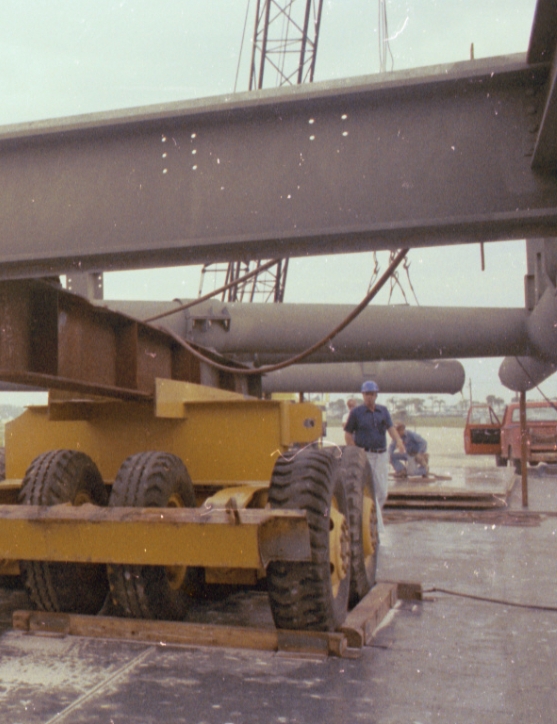
Somewhere along the line, somebody got a shot (and this is "full size" so you cannot click it to enlarge it) of my boss, Dick Walls, giving it a looking-over, and I cannot quite figure out where this photograph was taken (nor does the person who gave it to me know), but I've got a sneaking suspicion that it's in Palatka where the Truss was fabricated, not too long after it was first set down on top of the Prime Mover, which you can see has had its wheels good and chocked (look close and you can see where the lumber of those "chocks" has been restrained by bent-plate angles which are welded down to the deck of the barge, and no, that thing ain't going anywhere till they torch those angles back off the deck), to keep it from moving or shifting after they set the quite-substantial, quite-awkwardly-shaped, and extraordinarily dangerous monstrosity of an RSS Bottom Truss down on top of it, rolled it out onto the barge deck, and were getting ready to send it on its way.
The Truss was rolled to the Pad and placed directly in front of the Falsework it would then be lifted to the top of. In a very cramped location. Configured for the RSS in the DEmate position where you see it here. A place that, apparently, nobody else even considered, which of course made their bids for the job that much higher because of the considerable additional expenses associated with having to erect the RSS in the mated position, spanning the Flame Trench above the Box of the Mobile Launcher, the exact same way it had been done on Pad A.
And if you don't believe me about cramped, get a look at that crawler-crane closest to the bottom of the image. It's literally hanging over the side of the Flame Trench.
Cecil just bailed out completely on erecting the RSS over the Flame Trench at Pad B. Just skipped right around the whole thing, knowing he could make this lift, and apparently he was the only one, and not a single other person or entity thought a thing like this might actually be doable.
If you had to sum up Cecil Wilhoit's skill and knowledgeability in steel erection with a single word, that word would be brilliant. Cecil Wilhoit was brilliant with this kind of work in a way that no other person could match.
This lift is exceedingly ballsy in no end of different ways, and I marvel that Cecil somehow persuaded NASA to go along with it, but then again, from what I've learned about Cecil Wilhoit, he may not have bothered to even tell them that one of his cranes might be a little bit over the edge at some point, and just went at it, after very carefully examining all the aspects involved, and then deciding that yes, we really can do this.
And of course they did, and of course it worked, but...
This is very definitely not the sort of thing you ever expect to see when looking at heavy lifts.
Nowadays...
Nope. No way. Not gonna happen. Forbidden.
It was a different world, back in the early 1980's, and people had much larger conceptual envelopes in which to maneuver, and come up with creative solutions for things. NASA itself, at one point, in the very beginning, was a ballsy operation, and they knew they were taking enormous risks putting the very first humans on top of rockets they had yet to even figure out how to fly reliably in the first place, and they were just going at it, in a mad dash to beat the Russians, and although by 1980 a lot of those original people were gone, and a lot of that original culture had faded, much remained, and I presume it was those people, who were still a part of that culture, giving Cecil the go-ahead for this lift in the manner it was done. But I'm guessing. I really don't know, and Cecil might very well have simply put one over on them, too.
And Cecil knew his shit, and he knew what he was setting his crane on top of, and hanging part-way over the edge of, (and so do you, and go back to Page 59 and review what our Buried Stone Castle is made of, if you'd like) and he knew he was ok with what he was doing.
The Truss is thirty some-odd feet above the Pad Deck already, and has fifty some-odd vertical feet to go, and once it has cleared the top of the Falsework, the fun has only just begun, but we're going to stop here and linger over this image for a bit, looking closer at it, letting it tell us more. One of the things you might notice is the Stub Clusters where the pipes of the Truss come together at the intersection of different Column Lines. This is the best image we'll ever have to let you see why they called these things Stub Clusters, because... well... they're literal clusters of Pipe Stubs, and that's pretty obvious in this image.
I'm going to mark it up, so you can understand exactly what I'm referring to, ok? Click here for the marked-up version, which you can use to follow along with the below.
I've already pointed out that one of the cranes is over the edge, and it's labeled on the marked-up photograph, but I'm not going to beat on that one any more.
The Bottom Truss itself is labeled, complete with Column Line identification for Lines 'A', 'B', '2', and '5', and I've done that to make sure you can pick the Truss out from the bewildering snarl of foreground and background objects, and to also let you see the parts of it which will rest on top of their corresponding Falsework Column Lines, number 2 and 5, to hopefully give you a sense of both location and scale.
The partially-erected Hinge Column (and a nearby Strut) is labeled, and the top of the Hinge Column, laying in the shakeout yard, is also labeled.
Pipes in the shakeout yard, in two different locations, are also balled, telling you that they will become the RSS as they get welded together, up in the air.
Look close, on the Falsework for Column Line 2, and you can see a Union Ironworker in very close proximity to the Truss, which itself is in very close proximity to the Falsework Column, and he's giving hand signals to someone (I kind of doubt it's the crane operator, 'cause it looks like the Truss is in the way, blocking his vision) on the ground, advising of where they are, how close they are, and how well they're doing with clearances and all the rest of it, as the Truss rises ever so slowly into the air. My guess is that he's signaling to the ironworkers on the tag line, keeping things in line, but as with so much else, it's only a guess.
The Prime Mover is labeled. All three pieces of it.
And the pair of Union Ironworkers on the tag line are labeled, too.
And to finish off with the labeling, I've identified Tom Kirby's van, in the upper left of the frame. Cecil had passed away unexpectedly, shortly before Wilhoit did this lift, and Tom was Cecil's Project Manager, in similar fashion as Dick Walls was Sheffield Steel's Project Manager, and the entirety of the job had fallen unexpectedly upon his shoulders, and with Red Milliken as his General Foreman, he brought this one in. As an aside, Cecil had a son, Randy (I think), but Randy apparently had no interest in steel erection, and although the ownership of Wilhoit Steel Erectors fell to him upon his father's passing, I never once encountered him at the jobsite, nor heard of anyone else encountering him out there either, and once this job had been finished, Wilhoit, as a presence building launch structures out on the Cape, ceased to exist. I have no idea as to how all of the company assets were eventually disposed of, but disposed of they were, and Cecil's passing marked the end of Wilhoit Steel Erectors. This opened up an opportunity for Wade Ivey, and Ivey Steel, but it is nonetheless a sad footnote to the story, to see how such a well-oiled and highly-skilled group of people was dissolved and more or less cast to the winds of fate.
Let us continue on with this lift, using a photograph we first met on Page 8, which we've already seen, and which I've already referred you to on this page as well, farther above. At those junctures, I used the as-is version of the image, but here and now I've done some additional post-processing work to clean it up, clarify it, work the color-cast a little, and also enlarge what you get when you click on the image below these words.
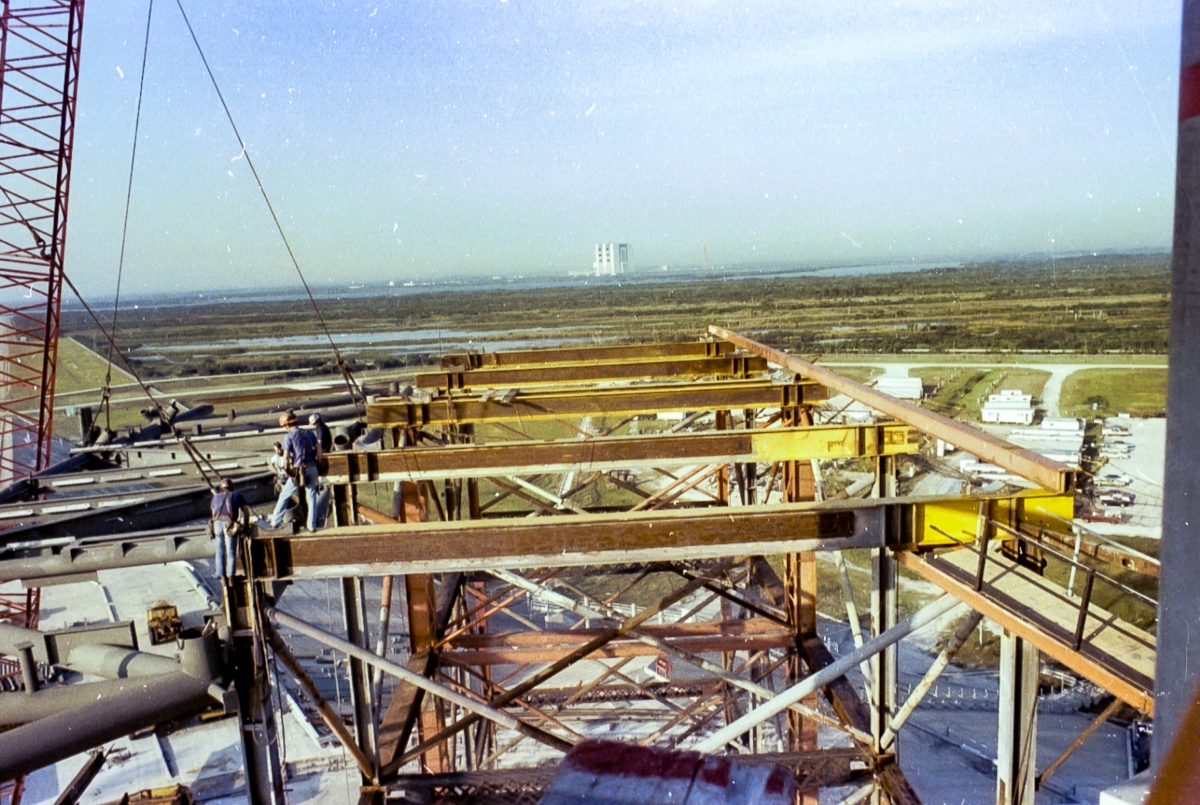
There's a lot going on here.
Let's have a look at things, ok?
First, no "safety" gear of any kind on any of the Union Ironworkers you see perched on the Falsework, making ready for the Truss to be pulled inboard, across the top of the Falsework, once it has reached an elevation to give it the vertical clearance it needs to do so.
This is how it was done, by the best in the business, in 1980, and this is how they preferred to do it, and any and all attempts by "safety" operatives to ensnare them in any sort of rope, line, harness, whatever, were met with hard-eyed contempt, and at this time, the lawyers had yet to gain the control over worksites such as this which they now hold power over today, and everyone on high steel was still free do do what they knew best, and what they knew best was to be given complete freedom of movement.
Here's the Truss once again, on my altered version of 79K14110 sheet S-21, as-lifted, just so you can kind of stay aware of what they were dealing with here.
You're looking at most of the Truss and Falsework from Elevation 140'-0" very near the southeast corner of the FSS, with a field of view that extends from nearly due south, to southwest. Here's 79K24048 sheet A-4, which I've altered by cleaning it up and removing a bunch of extraneous lines and unnecessary information, and then placing the Falsework Column Lines in their correct location, and then placing the RSS in-lift right next to them, with an overlay of light blue to show you the field of vision in our photograph.
And how might our gang of Union Ironworkers have gotten out to where they are on the Falsework in the first place?
The cranes are indisposed right now, lifting that Truss, so we can't use the skip box, right?
So give the lower right corner of the photograph a closer look, and what you're seeing there is a very temporary access catwalk, but unlike the NASA-engineered Access Catwalks we've encountered all over the place in this narrative already, this one's a little more... home-made? Maybe even it was made in the same home (or backwoods moonshine-still work area) they made the Skip Box in?
It runs out of frame to the right, to the place where you get on it from the FSS, and it's very likely the same one (which by then had been relocated to the east, closer to the Hinge Column, and up a little, to place the landing on top of the upper surface of the 24"Ø RSS Main Framing pipe that ran from the Hinge Column to Line B-2 at 134'-2" after the Truss had been set) I used to get to the place where I took my fateful first steps out across high steel, and you can see a little bit of the very pipe I traversed in this photograph, it being the very bottom member of the Truss, extending down out of frame at an angle..
And our makeshift catwalk is ratty. It's ramshackle. And it's the only thing that exists, between your boot heels and certain death.
Look at it.
Couple of lengths of scrap 6" channel iron, roughly welded to the underside of the Column Line 2 Falsework member. Can't see the one on the far side, but the near-side one looks like somebody tacked it to a piece of angle-iron welded on to the outer edge of that Falsework member's bottom flange, and two of the three stiffener plates above it. I see no sign of any bolts. If the weld lets go, then you get let go, too. Ill-fitting pieces of plywood tacked on top of that, and on the end where it meets the Falsework, there's a pretty good hole past the last piece. Not nearly enough to fall through, but plenty big enough to accommodate your foot in a leg-breaking way if you hit it wrong. And the handrails. Made from scrap somebody found laying around, tacked down to the channel iron it's resting on top of. And the two handrail runs don't even match. On the far side, lighter colored, round pipe rail goes all the way to the Falsework where the last post had to be trimmed off to clear the underside of the top flange of the Falsework member, and the horizontal piece that would have connected to it is also roughly torched-off, and yeah, there's some space in there you need to mind. On the near side, it's dark colored, very light tube steel, or angle-iron, or scrap rebar, or some damn thing. And where it "meets" the falsework, there's not even a terminal post at all, trimmed-off or otherwise, and the intermediate runner just kind of "stops" over there in the vague area of the Falsework, and there is no top runner at all, and that middle runner can't be very strong at all, cantilevered out there like it is, and the end of it constitutes a marvelous snag hazard, and if you wanted to put your snag hazard in the most dangerous place you could think of, well... this one's doing pretty good that way too, 'cause it's wide open over there, and the last four feet or so of that catwalk, on its east side, where it "meets" the Falsework, is... just about a dangerous goddamned motherfucker!
And of course, it just keeps stepping up from there.
That Falsework member looks like some kind of light W33, maybe a W30, or even a W27, and either way, it's a pretty tall step up to its top flange from the last grating panel on the catwalk.
I'd wager the flange width on that thing is one foot, maybe a bit less, and for Union Ironworkers, flange widths of one foot are literal sidewalks, and treated in similar manner, and who the fuck in all the word could find a way to fall off of a sidewalk?
Well...
You or I might.
Or at least we might until we develop proper legs for high steel.
And of course, the thing being nearly three feet deep kinda spices it up some too.
Stop right now. Go get a tape measure. Measure out 30 inches above the ground you're standing on. Now take a one-foot-wide length of anything, and arrange so as it intersects your location at an angle, 30 inches above the soles of your feet, crossing it as it does so.
Got all that? Got a proper feel for all that? Got a proper feel for stepping up onto your one-foot-wide anything?
All of a sudden, it's more than just a little bit awkward, and you need to mind to keep from overdoing it as you step up, and going over the side, over there on the far side of things.
Yeah. All of a sudden, dry words and tedious numbers turn into a bit of a test.
Can you do it?
Sure, why not?
Ok, fine.
Now take the whole works eighty feet straight up into the air, above the concrete down below.
Now step up!
Yeah.
Now it's not so much fun anymore, is it? Now it has become a game that you no longer want to play.
And of course it's not a game. It's your fucking job, and you do shit like this more times each day than you could possibly count.
Go back and look at that damn photograph again and consider it.
And once you're properly feet-down on your sidewalk...
You very reasonably take a walk on it.
With the cold hands of Certain Death brushing against your shoulders on either side, the whole way.
Over to where your fellow ironworkers are waiting impatiently for your worthless terrified ass to get over here and get to work, goddamnit!
There's four ironworkers over there. Two of them are out at the front end of things on RSS/Falsework Column Line 2, and two of them have had to walk the long way around, via the tie member running full-length across the back of the Falsework corresponding to RSS Column Line A (another wholly-unguarded step up and step down to do so), to get out to the end of things on the front side of the Falsework on Column Line 3.
One of the guys on Line 2 looks like he's getting ready to step out onto the Truss as it continues to rise toward him, and one of the guys on Line 3 looks like he's already done so, and is now riding it.
And for the moment, they're all taking it easy.
It's easy money up on high steel.
You just stand around and wait for shit to happen, and only then do you go to work.
Nothing to it!
Easy Money.
Ok, back to the lift.
And back to the extreme-low-quality near-worthless images which are all we can find anymore, with NASA sitting on all of this stuff, refusing to release any of it, like it was Secret Plans To Build The Bomb, or something, but actually because the people whose hands this stuff fell into are Lazy Bureaucrats with a rubber stamp marked "I.T.A.R." which they just went around and blasted everything with, not knowing in the slightest what any of it actually is, and thereby making their day at work that much easier, because they no longer have to disposition any of it, because all of it is now in a locked vault, never to be seen by human eyes again. Feh.

And this is another "full size" image, so you cannot click it for any enlargement, alas.
None of our Union Ironworkers who were visible in the previous color image above this one on the page are on the Falsework anymore. The "quality" of this photograph his heartbreakingly poor, and I can still (barely) make out the pair on Line 2, both of whom are now down on the suspended Truss, but on Line 3, I can only see one, who appears to be headed out across the span toward RSS Bottom Truss Column Line B, and the other one over there is hidden from view somehow, be it obscuration by intervening steel, or insufficient resolution of the image. Work is now being done in preparation for the next major phase of this lift, and this next phase is more than just a little bit radical. Before we get there however, take note of the two-legged slings hanging from crane hooks just out of view, above the top of the frame. To this point, the entire life was done with these two-legged slings, one leg to Truss Column Line B, and the other to Truss Column Line A, on both cranes. This is about to change. In mid-lift.
So let's take a look at our next pair of photographs.
What the fuck?!
How the fuck did the Truss suddenly get rolled over sideways, sitting edge up?!
This makes no sense at all.
They had it right, flat and level, just the way it sits when it's buried inside of the completed RSS down at the bottom of things, centerline at elevation 134'-2".
And now this?
Why?
Lotta goddamned extra time and work to do a thing like this.
Had Cecil, or Tom, or Red gone mad?
Probably not. Of course not. And in fact, they're the only ones who know what's really going on, and why an outrageous departure from an already-correct orientation of the Truss might be advantageous, and might even be sitting squarely on The Path of Least Energy.
And we're right back to Cecil being the only one who could see, how putting the to-be-built RSS in the demate position for erection could even be set up in the first place, using a pair of standard-issue cranes to make the initial lift that would allow everything else which followed to even work in the first place.
And in the initial phases of the lift it was all about finding room, which, as we've seen, involved hanging over the side just a little bit, and in this phase of the lift, it becomes a matter of reach.
The higher a crane booms UP, the more a crane pivots its boom toward the vertical, the closer the top (load-bearing) sheaves wind up getting to the crane's cab (and counterweights). And the concepts of simple leverage (and I still become irritated at how the business majors have stolen that word, turned it into a bastardized verb, and have managed to redefine it, and I'm using it now with its proper high-school- physics-derived definition) tell us that the closer we bring our top sheaves and the line(s) that hang beneath them, carrying the load, the heavier a weight we can lift without turning the crane over while attempting to do so.
And of course the reverse applies, too.
The farther we boom DOWN, pivoting the boom toward the ground, with the crane boom becoming more and more parallel with the ground the crane's sitting on, the farther the top sheaves and load line(s) get from the crane's cab and counterweights, the LESS of a load we can carry, before the crane tips over in a lethally-catastrophic unplanned event.
And as you're booming up or down, relocating your load closer or farther from the crane's cab as you do so, you simultaneously work your load lines, coming down on your runner, or coming up on your runner (these are the words used by Union Ironworkers when giving verbal instructions via radio to the Crane Operator), to keep the vertical location of the load steady, keeping it always at the same height, as you work the crane's boom up and down.
So.
As Elmo McBee said to me that morning oh-so-many years ago, "You can pick up the world with an inch of steel," and that's very true, but... if you pick the world up with your crane boomed up, with your load, the "world," nice and close to the crane's cab, all well and good... until you start booming down, and start relocating the "world" farther and farther away from the crane's cab as you do so.
'Cause at some point...
You're going to have boomed down too far, and the load is going to get a little too far away from the crane's cab, and LEVERAGE, is going to turn the crane over in a horrifying crash, and the "world" is going to come plummeting down to the ground when that happens, and...
LEVERAGE.
Boom up, boom down.
And watch leverage work on your load as you do so, and you've already been told a story about what happens when too much load gets too far away from the crane's cab, and it ain't pretty.
So.
Cecil could take two standard-issue cranes, booms pointing high, toward the vertical, and pick the damned Truss all the way UP in the first place, and he could even "walk" the cranes, using their crawler tracks to do so, taking the truss farther out and part-way across the top of the Falsework in so doing, but he could not boom DOWN far enough to get the Truss all the way over there, where it had to be located in its final erection position.
So.
What to do?
And this of course is where Cecil Wilhoit's brilliance shined a very bright light indeed, into a dark place where nobody else could see anything at all.
Alas, we do not have any photographs of it. The bastards in charge of releasing this stuff, or not, are sitting on their dead asses, refusing to disposition it, and have no inclination get up off their dead asses, do their fucking jobs, and release this fantastic story in photographic form to the wider world, so that everyone might see just how radical things were this day.
And Cecil's plan involved getting the Truss up above the top of the Falsework, just far enough, and then booming down (while simultaneously coming up on the load lines to keep the Truss at its required elevation above the Falsework) as far as possible to get the Truss as far out there as possible, to give himself more reach, and then letting down on the load lines just enough to allow the far side of the Truss, the Column Line A side of the Truss, to come to rest on top of the Falsework where it was, letting the Falsework carry enough of the load for the time being, and then hooking on to the Truss with the jib lines, to the Column Line B side of the Truss, the side closest to the cranes, thereby taking a rest of the load off of the rigging that was supporting it on Column Lines A and B from the top sheaves via those two-legged slings you have seen in every image prior to the pair directly above these words, releasing that rigging with its two-legged sling, and reattaching it to Column Line B side only, and then very gingerly coming up on those load lines, drawing the Truss upward, simultaneously booming down to gain more reach while doing so, until the Truss was in a vertical edge-up orientation like you see it in the two images above these words.
This.
Is.
Fucking.
Radical!.
Nobody else so much as even imagined that a thing like this could be done.
And Cecil Wilhoit came along and simply did it.
Just another day on the job.
Ok, now what?
We've got ourselves 160 feet of weldment, weighing 150,000 pounds, with its bottom side eighty feet up in the air, on its edge, sitting on top of the Falsework that was built to support it in its final flat orientation, but we don't have enough REACH with our cranes to get it all the way over to where it goes.
If we boom down while coming up on our runners any farther, we're going to turn the cranes over, lose control, and the Truss will fall, and the result will be a catastrophe, so...
What the hell do we do NOW?
We're stuck!
And in the absence of any photographic evidence (thanks NASA I.T.A.R. guys, thanks for keeping us all safe by locking this stuff away like you did, you lazy bastards you), we must now rely on the only other thing we've got.
And the only other thing we've got is James MacLaren's uncomprehending eyes, as he witnessed this astounding tour de force, from his chair inside of the Sheffield Steel field trailer, looking out the big sliding glass doors across and above Wilhoit's field trailer, not believing what he was seeing.
Stop and go back up to the last photograph of the Gox Arm Hinges Support Strongback Lift we've seen so far, and give James Dixon another look, and see how he's working a come-along to brute-force the Strongback into its final position. His come-along is mostly not-visible, laying flat down on the FSS 300'-0" deckplates, hidden behind the perimeter toeplate up there, and the wire rope coming off of it is also hidden behind that toeplate, headed over to whatever snatch block arrangement they put together up there, also hidden, behind the Strongback itself, connected to the far side of the Strongback, away from the come-along, where our anonymous ironworker is hanging over the edge, giving everything a close examination, where the come-along wire is finally looped around the Strongback where you can see it there, below his left hand.
Come-alongs.
Amazing amounts of force can be applied, bare-handed, through the leverage that a long handle on a come-along gives you.
Just like it's giving James, in that photograph.
And this is exactly what Wilhoit did with the RSS Bottom Truss.
There's five lines of Falsework.
And they put ironworkers out there on all five lines, farthest away from the Truss, out there at Line A, and they threw wire ropes around the bottom of the Truss, around the Column Line A structural pipe member at each Falsework line, and they gave all five of them come-alongs, and then, slowly.... oh so very slowly... in conjunction with the crane operator very very carefully letting down on his runner while pulling his load lines back, drawing them back toward the Flame Trench, they brute forced that goddamned 160 foot long 150,000 pound monstrosity across the top of the Falsework, until it had been laid all the way back over, back to its proper flat orientation, right where it belonged.
And they did it without enough crane, using the Falsework and bare human muscle to make up the difference, and by god that's how they came in low bidder and got the job, when nobody else could even conceive of doing such a thing.
And I sat there in the Sheffield trailer transfixed as I watched those five ironworkers on those five lines of Falsework, blazing away at it, all working the handles of their come-alongs like demons, and in exquisite ultra slow-motion the fucking thing laid down just as pretty as you please, like it was no big deal, and they wrapped it up, removed all the rigging, drove the cranes away, and that was that!

Done!
Unbelievable, but true.
So ok. So now you know a little bit more about how it was done, and now you know a little bit more about how it gets done.
Let us now return to the GOX Arm Strongback, still dangling in the air, up at the top of the FSS.
Which is yet another sterling example of how ironworker cunning allows for the successful prosecution of extraordinarily difficult and dangerous work efforts, using equipment (and time, and money, of course), at a minimum so bare as to defy belief.
But of course the pictures do not lie, right?
And my own bootprints are on the goddamned thing, too.
So you get to take my word for it, in addition to the photographic evidence you are seeing with your own eyes.
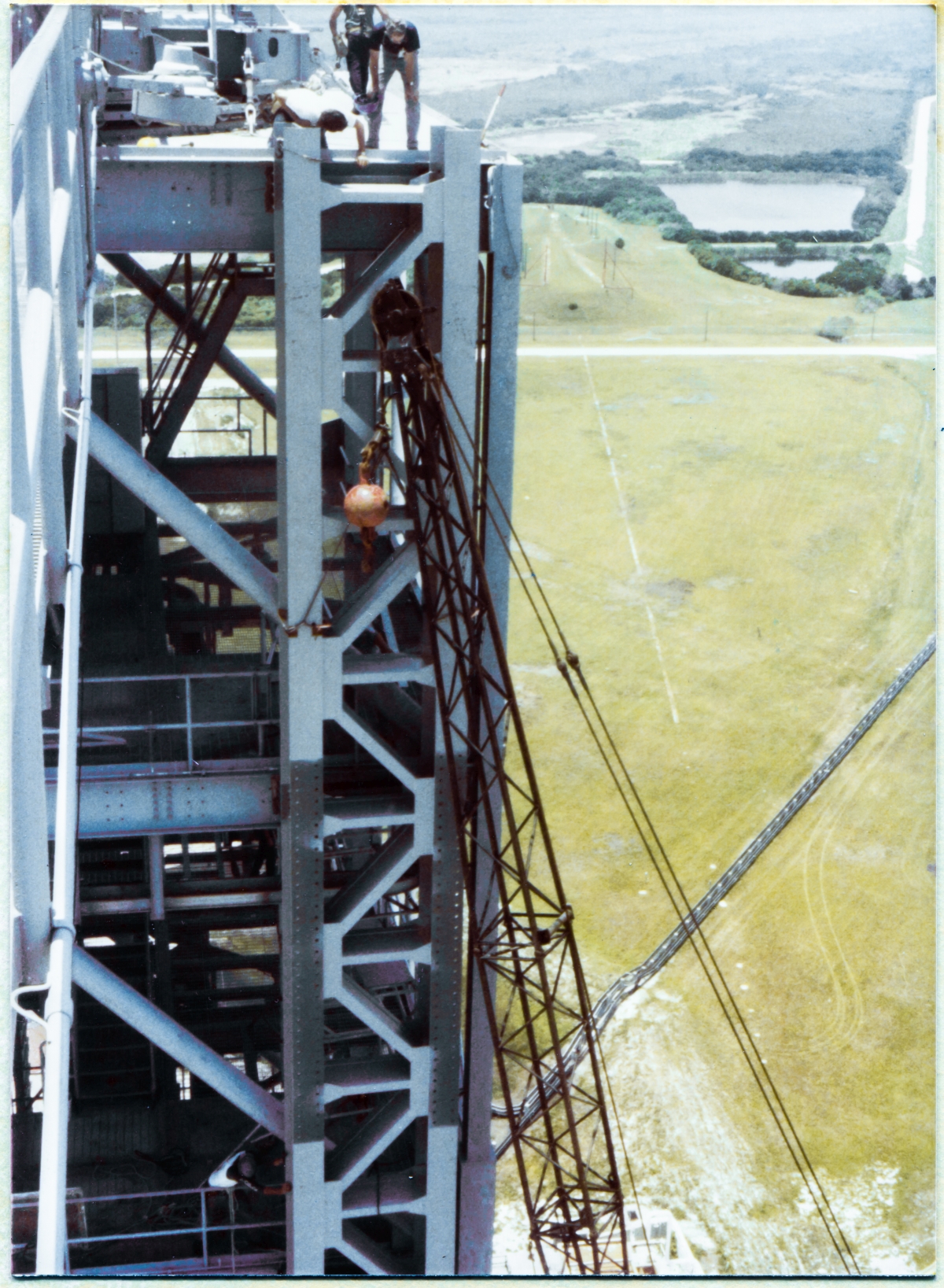
And here we see Wade Ivey, owner of Ivey's Steel Erectors, personally inspecting things, leaning out over the edge, standing on the checkerplate at FSS Elevation 300'-0" looking down at the top of the Strongback with its connection bracket very nearly dead-center on the areas where it will be welded to the web of the FSS Perimeter Framing beam, making sure, for himself, that everything is right where it needs to be, going right where it needs to go.
In the time elapsed since the previous image in this series was taken, the Strongback has been raised the last little bit required, and is now at its finish-installed elevation, with its two big W24x104's now extending 1'-1½" above the FSS deckplates at Elevation 300'-0", as per 79K24048, sheet S-107, View D.
For this image, I had come up from underneath the lower handrail runner out at the end of the Hammerhead Crane, walked just far enough toward the FSS to keep the third large light fixture, the one closest to the far end of the Boom, out of my frame, and was now merely leaning out and over the top of the handrail instead. Safer? Maybe. Maybe not. I'm still out there far enough to keep the Boom out of the area of interest, which means I'm still... out there.
Two levels down below Wade, down at 260'-0", Reuben Chiles is working the bottom end of the Strongback barehanded, for precise vertical alignment, plumb, square, and true, and once it's all finish-located properly, top, bottom, and middle, it will be snugged up against the steel of the FSS, and then the business of properly attaching it can begin.
From here, where you see them in the image above, things slow way down, the Strongback moves by inches or even millimeters at a time, and there's no further point in me standing around out at the end of the Hammerhead Crane. You're now seeing the Strongback essentially where it will go, and additional frames from out on the Crane Boom can add nothing of sensible use to what we already have.
From this point on, once the Strongback is properly snugged up, hard against the FSS Perimeter Framing steel, the crane operator simply makes sure that nothing moves, and the same is done with the rigging from the FSS to the Strongback, too.
Floats will be lowered over the side at all three elevations, 260'-0", 280'-0", and 300'-0", beaters, drift pins, spud and air impact wrenches, along with welding gear, grinders, and needle scalers, will all be brought to those areas requiring them. Ironworkers will death-defyingly position themselves high above thinnest air, out on the floats, and the final fastening will be undertaken to the sight of welding-hoods down, with sparks and welding slag flying, and the harsh staccato sounds of needle scalers knocking slag off of completed weld passes and air wrenches torquing high-strength A325 structural bolts, interspersed with the metallic whine and screeching of grinding discs against iron.
Inspections will follow, the crane and rigging will be unhooked and taken elsewhere, final touch-up paint will be applied, more inspections and final approvals by contractor and NASA oversight entities will follow, and then it will all be broken down, floats, gear, and all, removed and made ready for whatever might come next, elsewhere on the towers.
The Strongback will ineluctably force the GOX Arm which will be bolted to it later on, into its one-and-only service location high on the FSS, where it can swing on a pair of large hinges out and away from its stowed and latched position up against the face of the FSS on Side 1, taking the "Beanie Cap" which it carries, and which is the Business End of things, out to a position where it can be lowered down ever so close, but not quite touching the Space Shuttle's External Tank, where it can do its job, preventing extremely cold gaseous oxygen which vents from the very top end of the tank, from causing ice build-up on the outer surface of the tank, which might then break loose during Launch, with potentially catastrophic effects were it to impact the astoundingly-delicate Thermal Protection surfaces of the Orbiter.
We will be seeing much more of the GOX Arm and Beanie Cap later on, but not now.
For now, we are done with the Strongback, and can depart the area.
But on the way back in to the FSS from our previous vantage points out on the end of the Hammerhead Crane boom, let's stop, and get one last frame, standing very nearly right where we saw Rink standing, looking things over closely, from a location that allowed him to see things, top to bottom. Let us look through a Union Ironworker's eyes, at the world he inhabits, and try, all we can do is try, to imagine...
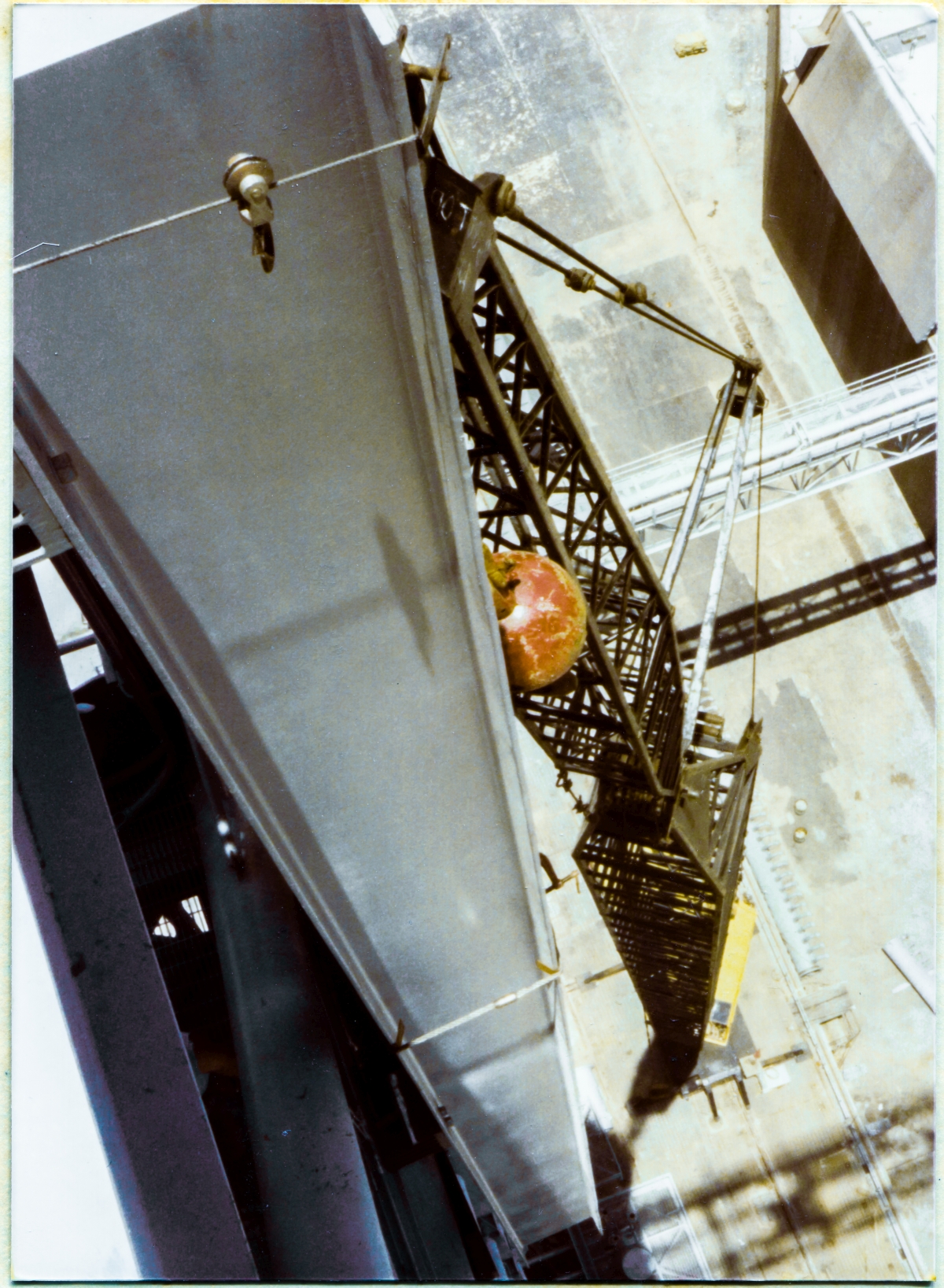
...what it must be like up there, 300 feet above the bottom of the Flame Trench with the latticework shadow of the North Piping Bridge cutting across it, which lies just over the crane operator's left shoulder, just beyond the 50 foot precipice which defines it.
Excepting frames of my own child, I'm pretty sure this is the best photograph I've ever taken in my life, and I know I'll never get another opportunity like it again.
And for this, I am beyond thankful. Thankful beyond imagining.
Return to 16streets.comACRONYMS LOOK-UP PAGEContact Email Link |
